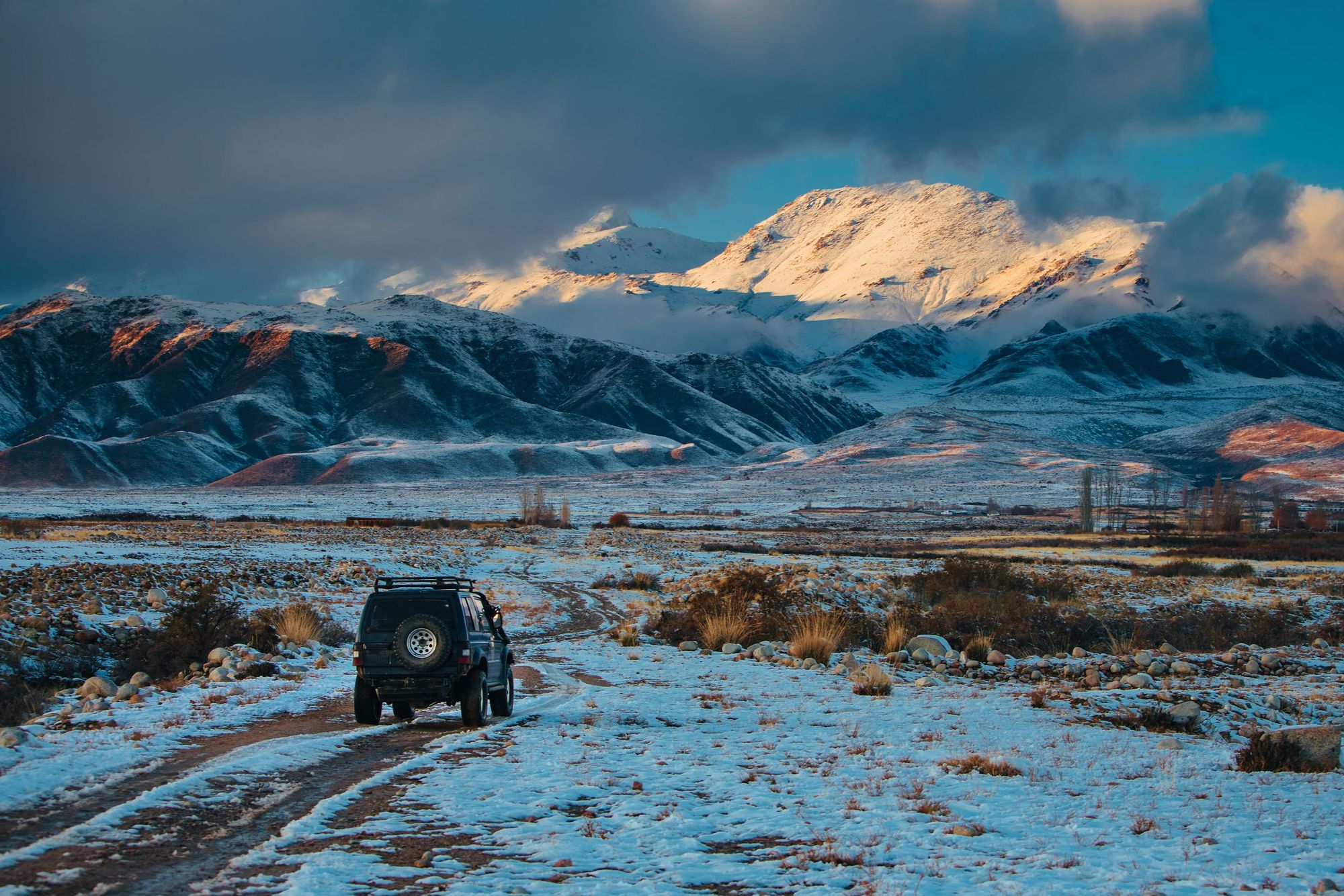February is a small but mighty month for travel. The northern hemisphere is well and truly settled into winter. The hat, gloves and down jacket are kept handy for regular use, the hills are sprinkled with frost – or if you’re lucky, buried under a few feet of snow – and the days may not be long, but that just means you don’t have to get up so early to catch the sun rise.
It’s likely you’ll see a more authentic side of wherever you decide to visit…
Of course, in other parts of the world, you can still escape from the cold and grab some winter sun on a toasty island – whether that be the Maldives or the far-flung São Tomé and Príncipe.
What that means is that the best places to travel in February are dependent on what sort of adventure you want – but whether that’s deep snow and northern lights or sun and safari, if you look hard enough, you’ll find your dream spot.
Search Our Trips | Much Better Adventures
Travel with us on a proper adventure. Unique small group adventures without the logistical headache, helping wild places thrive one adventure at a time.

Given that February is also off-season in most of the world, you can also expect lower prices, less crowds and more relaxed locals. It’s likely you’ll see a more authentic side of wherever you decide to visit as a result. So, sure, February might be the shortest month of the year, but for travel, it can also be the best.
Here’s our guide to the best travel destinations in February – a month for those with wanderlust.
1. The High Tatras, Slovakia
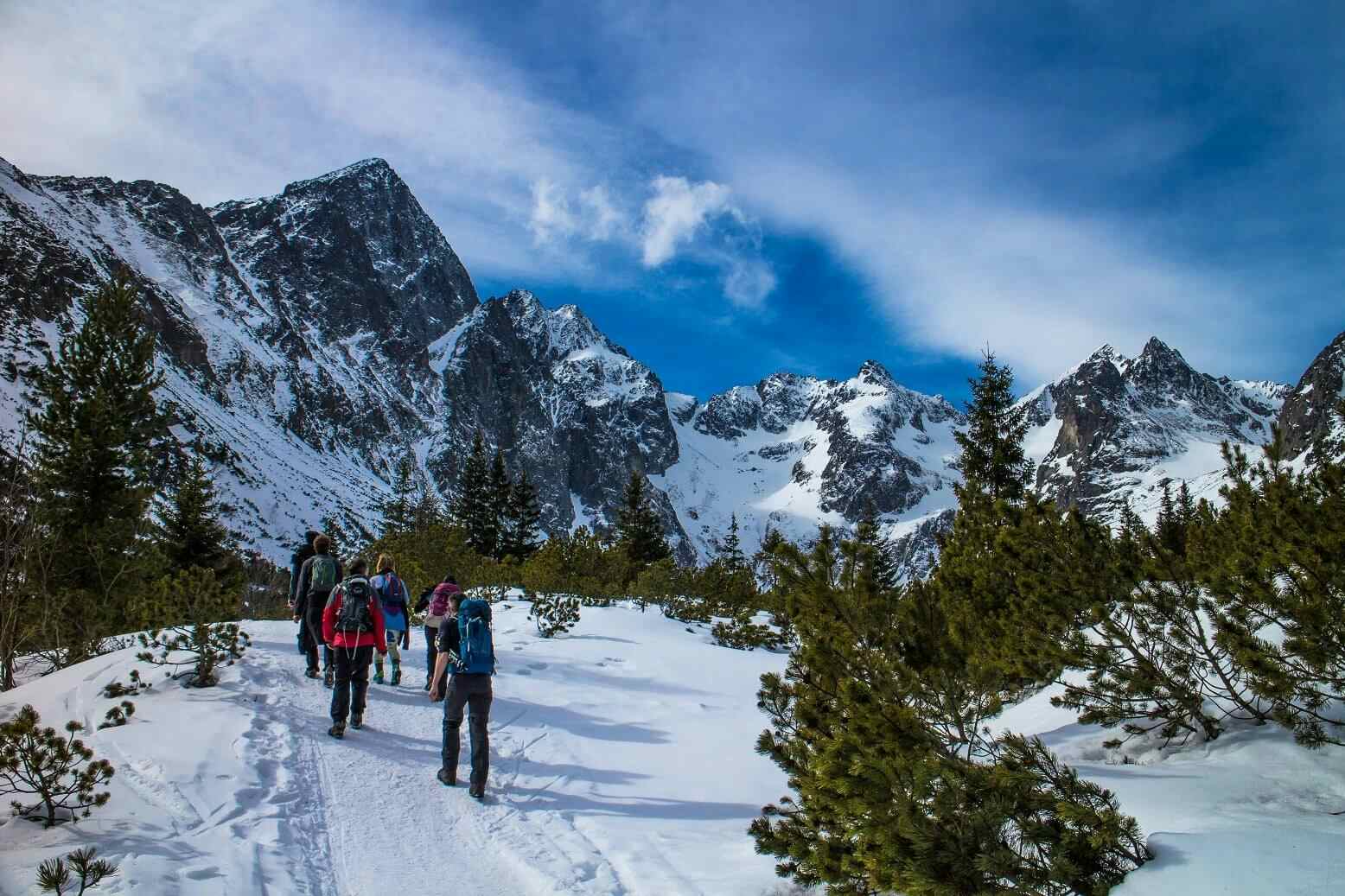
- Season: Winter
- Temperature: -2°C high, -9ºC low
- Time zone: GMT+2
- Currency: Euro
- Best for: A snowy mountain adventure off the beaten track
Most people don’t know an awful lot about Slovakia. It’s a beautiful country – and that’s never more obvious than when you’re hiking in the High Tatras Mountains, a remarkable, high, rugged mountain range which runs along the border of southern Poland and northern Slovakia, in the Prešov Region.
Head to the High Tatras in February and you can trek through 48.5 miles (78km) of unspoiled mountains, traverse untracked powder and discover verdant pine forests. When you’re done exploring the snowy outdoors, head back to soak your aches away in the steamy natural thermal springs.
How to get there? Fly to the Krakow John Paul II International Airport, Poland. It’s around a three hour transfer from here, and is closer to the High Tatras than the Slovakian capital of Bratislava, which is on the border with Austria to the west.
Hike Slovakia’s High Tatras Mountains in a Weekend: The Winter Edition | Much Better Adventures
Join a small group adventure trekking the fresh snow of the High Tatras Mountains over a long weekend, then soak in steamy thermal baths.
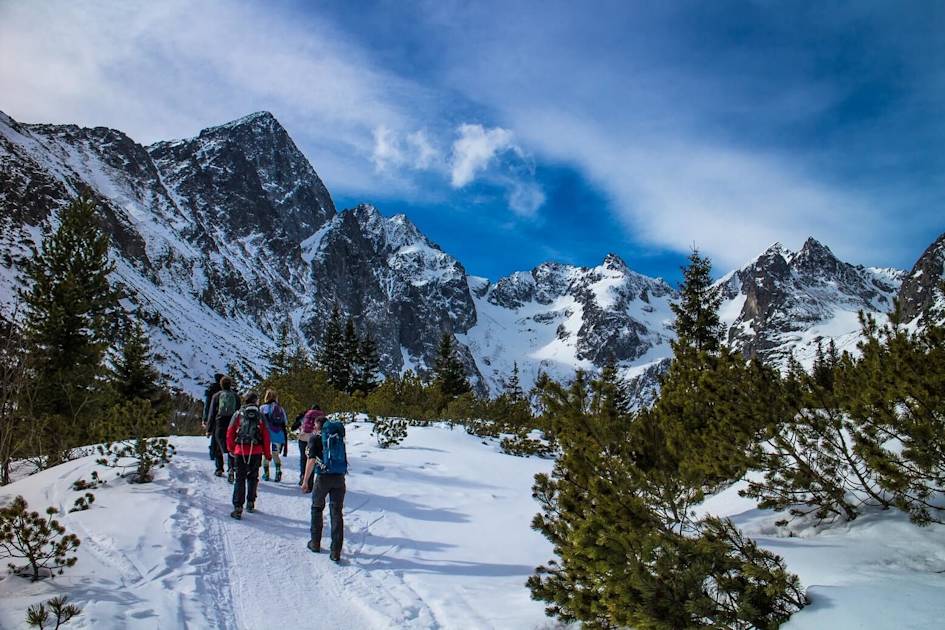
2. Lahemaa National Park, Estonia
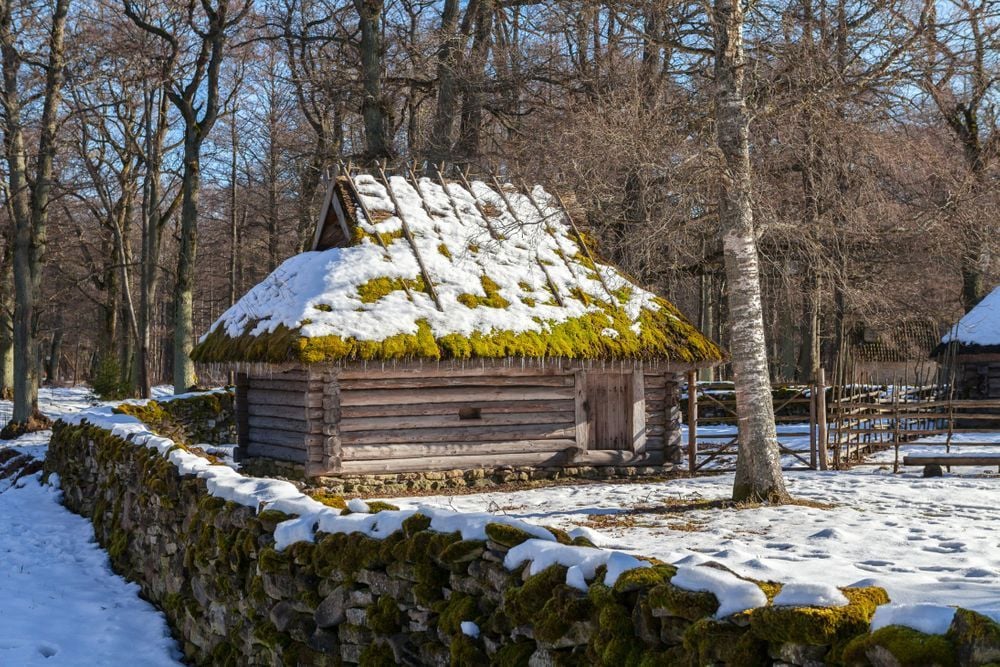
- Season: Winter
- Temperature: 0°C high, -10ºC low
- Time zone: GMT+2
- Currency: Euro
- Best for: Hot saunas and snowy forests
Estonia is a country where smoke saunas are built into the national identity – so much so that the art of the Estonian smoke sauna is actually UNESCO protected.
Now, you can enjoy a sauna whatever time of year in Estonia, but never is it more delightful than in winter, when the snow has fallen and you can use that hot sauna to escape from the cold. This is a great, lesser-known destination for going snowshoeing, sledding, hiking and fat biking through native forests weighed down by powder – and then getting nice and warm in the log cabin after.
How to get there? Fly to Tallinn, the Estonian capital. It’s a one hour drive to the park from here.
Estonia in Winter: Snowshoeing, Hiking and Sauna Trip | Much Better Adventures
Join a small group tour to hike, sled and fat bike through the snow, stopping off for steamy saunas and icy dips on this Baltic winter adventure.

3. Abruzzo, Italy
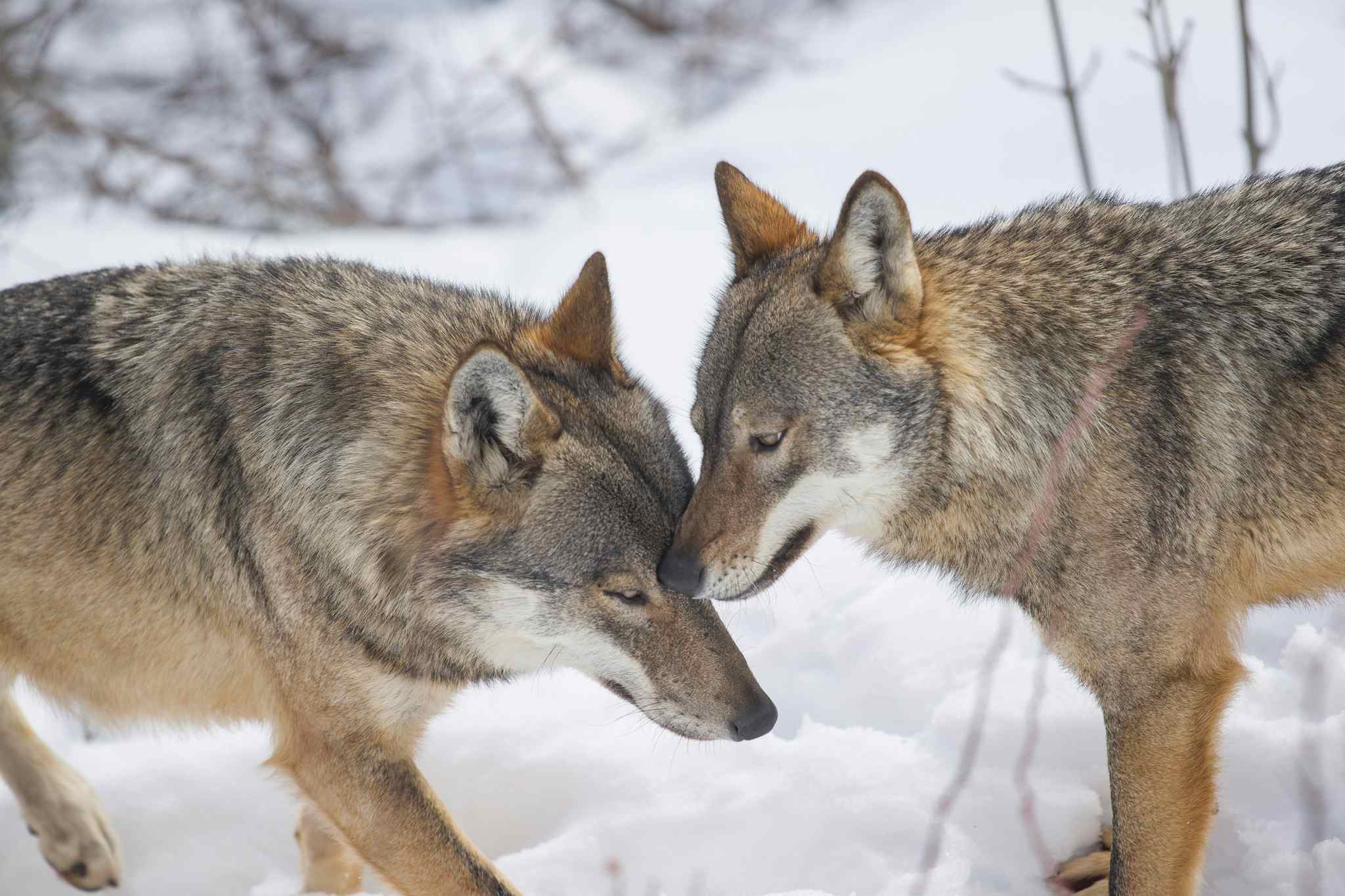
- Season: Winter
- Temperature: 8°C high, -5ºC low
- Time zone: GMT+1
- Currency: Euro
- Best for: Wolf-tracking in the winter snow
Abruzzo is the garden of Italy. “They say the region is the greenest in Europe, because such a big portion of the land is protected by parks or reserves,” says Angela Tavone, of Rewilding Apennines. Her organisation has been working to rewild the area, creating wildlife corridors.
Go wolf-tracking in the snowy mountains in February and you can contribute to the work which is allowing those conservation efforts to thrive. There’s nothing quite like going full Aragorn and heading out tracking – particularly in the snow, when you can look out for the cute little paw prints of the wolves, and hopefully spot the pack walking in the distance. Simply unforgettable.
How to get there? For Abruzzo, you’ll want to fly to Rome, which is around two hours away.
Winter Hiking and Wolf Tracking in Italy | Much Better Adventures
Join a rewilding adventure in the Abruzzo Mountains, created in partnership with conservation experts and local wildlife trackers.
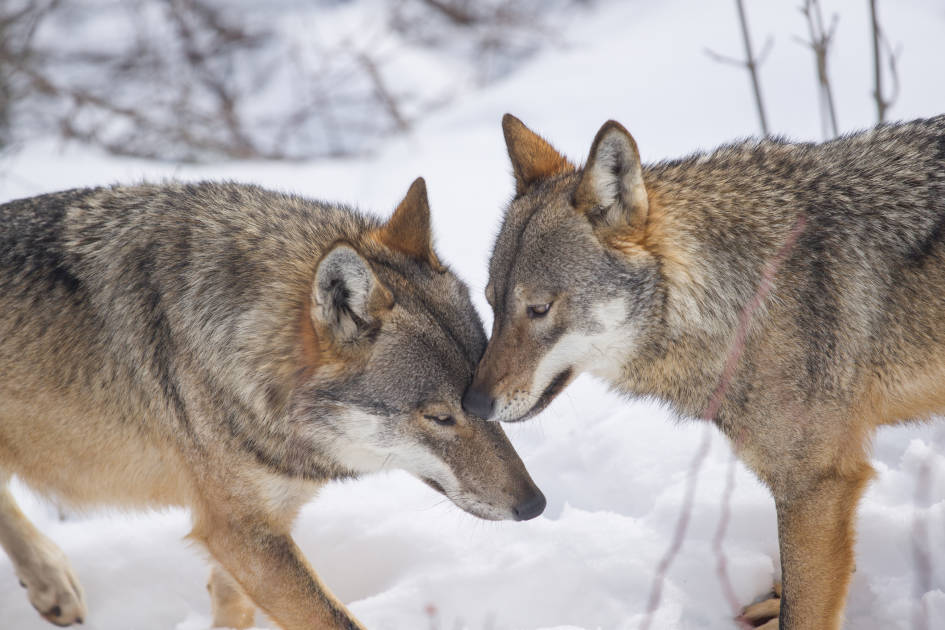
4. The Julian Alps, Slovenia
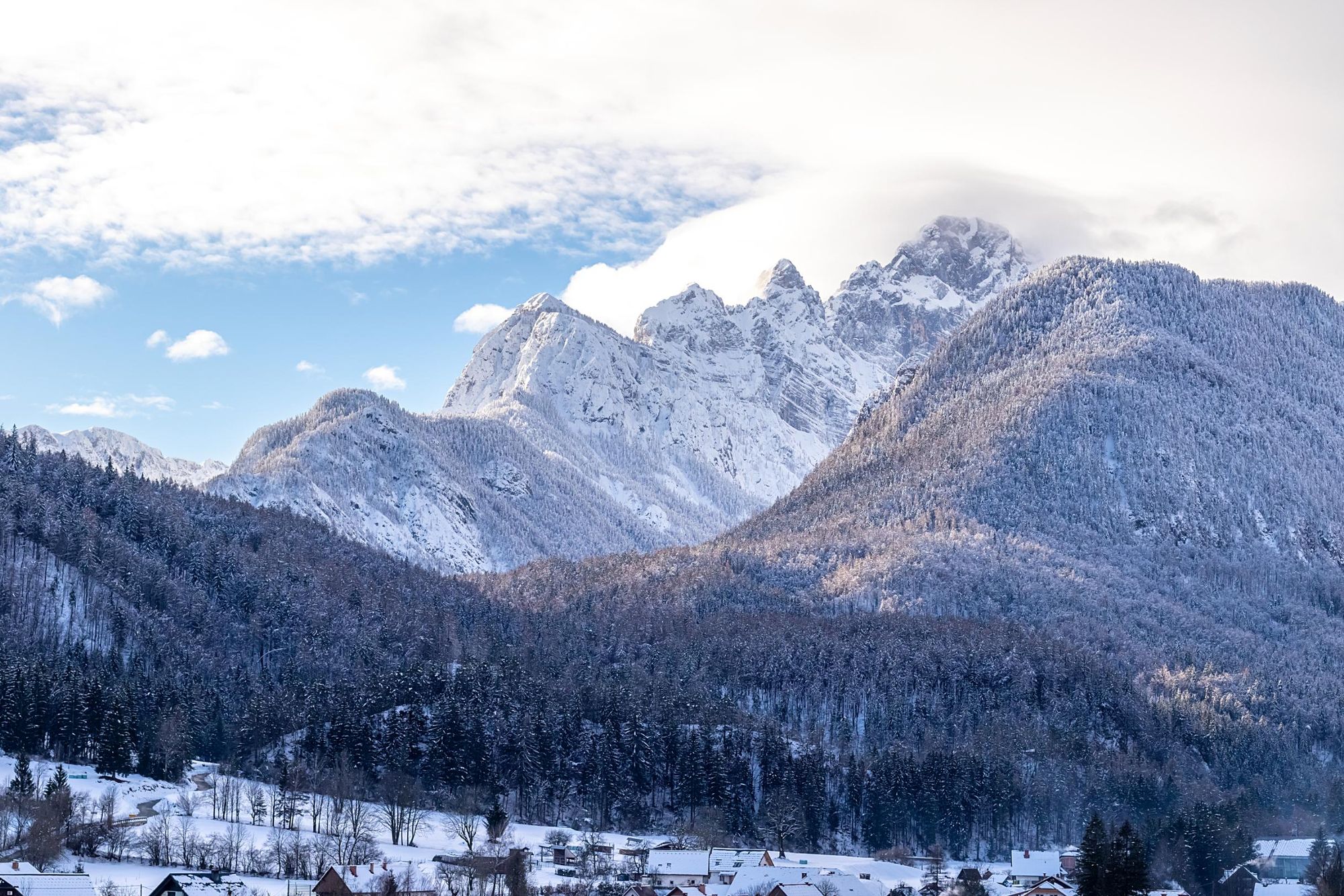
- Season: Winter
- Temperature: 8°C high, -10ºC low
- Time zone: GMT+2
- Currency: Euro
- Best for: Jaw-dropping alpine views without the crowds
Slovenia is rightly now on the radar of many budding adventure enthusiasts, but the stunning Julian Alps of the country – which are just as big and beautiful as those elsewhere in the range – still have a substantially smaller footfall than those in France, Italy and Switzerland.
Visit them in February and you’ll find these mountains particularly quiet, making it the perfect time to visit the glacial Logar Valley, go hiking in Triglav National Park or visit quaint mountain towns like Gozd Martuljek. Take in the imposing peaks of the Jalovec, Mojstrovka, and Ponca – all over 2000m – and you’ll leave amazed that these trails are so quiet. Before departing Slovenia, do drop by the beautiful Bled and Bohinj, and the picturesque capital city of Ljubljana.
How to get there? Fly into Ljubljana, the capital of Slovenia.
Hike and Kayak Slovenia in Winter | Much Better Adventures
Join expert guides to snowshoe through the Julian Alps across Slovenia and Italy, a winter wonderland of frozen lakes, snowy forests and warming saunas.
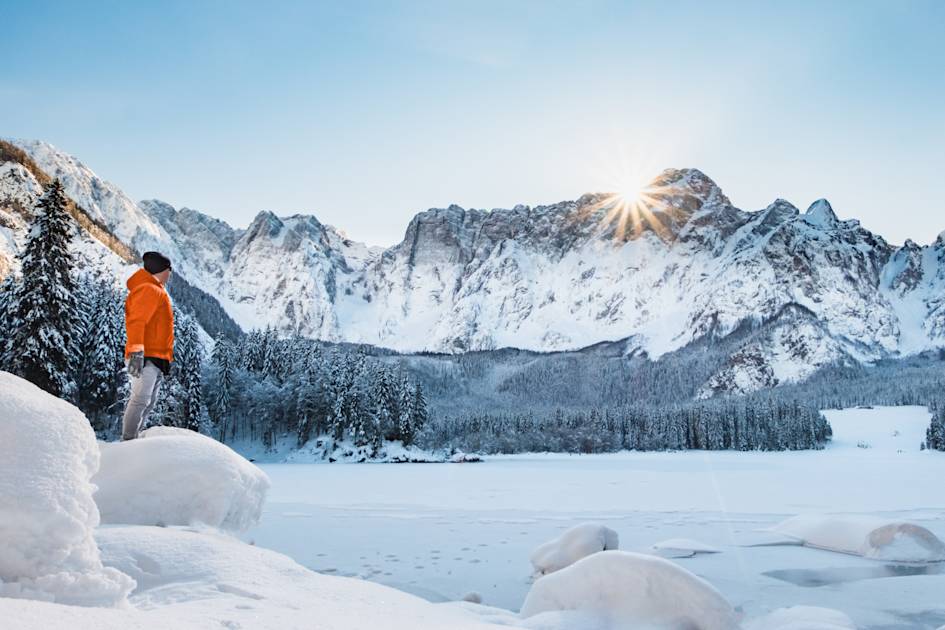
5. The Highlands of Iceland
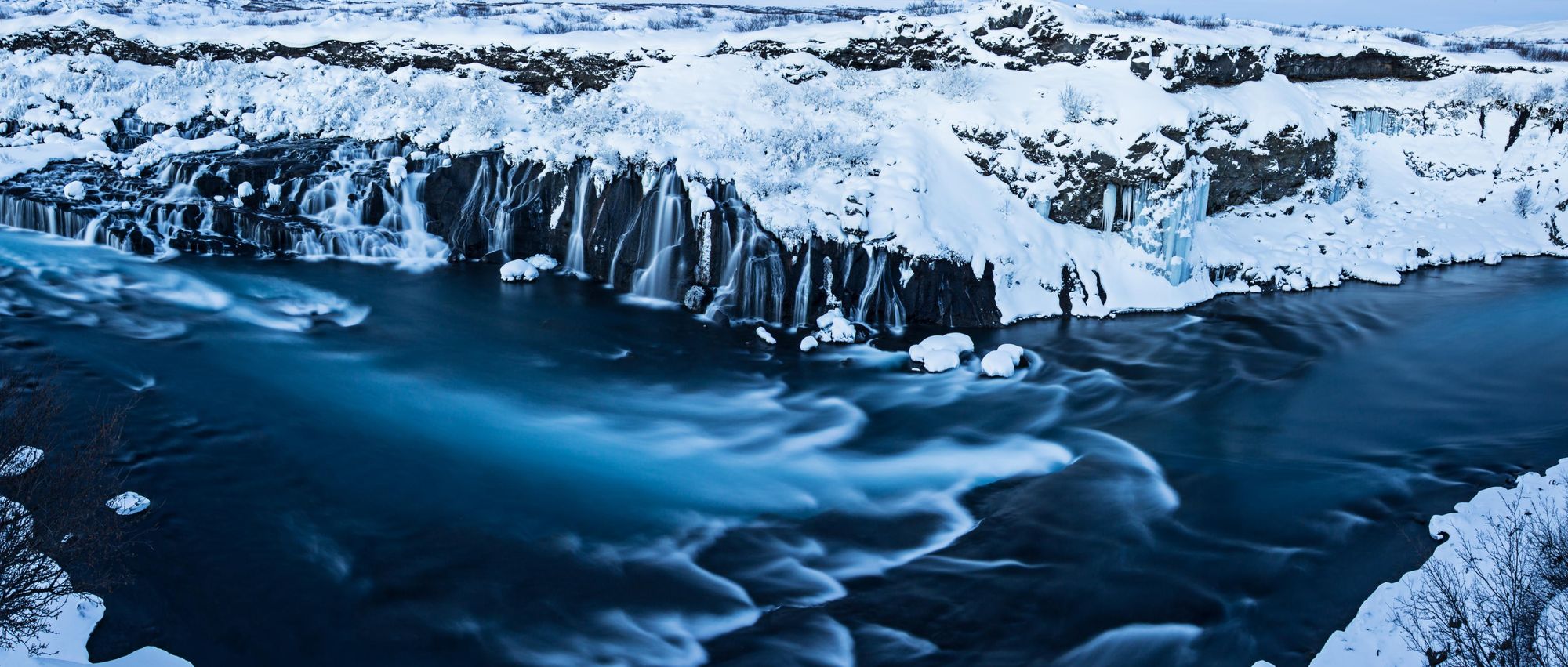
- Season: Winter
- Temperature: 3°C high, -3ºC low
- Time zone: GMT+0
- Currency: Icelandic Króna
- Best for: Hunting the northern lights
Turn your February otherworldly with a trip to the tectonic plates and steaming geothermal valleys of Iceland. Stick on your crampons and explore the Sólheimajökull glacier, an outlet glacier of the mighty icecap of Mýrdalsjökull.
Explore the waterfalls of the country, icy in the winter colds, and spend your nights looking to the skies, watching out for the colours of aurora borealis.
How to get there? Fly into Keflavik Airport, which serves the capital of Reykjavik .
Hike Iceland’s Golden Circle and South Coast in Winter | Much Better Adventures
Join this small group tour to hike to hot springs, visit icy waterfalls and gaze at the aurora with an expert local guide, bunking down in cosy farmstays.
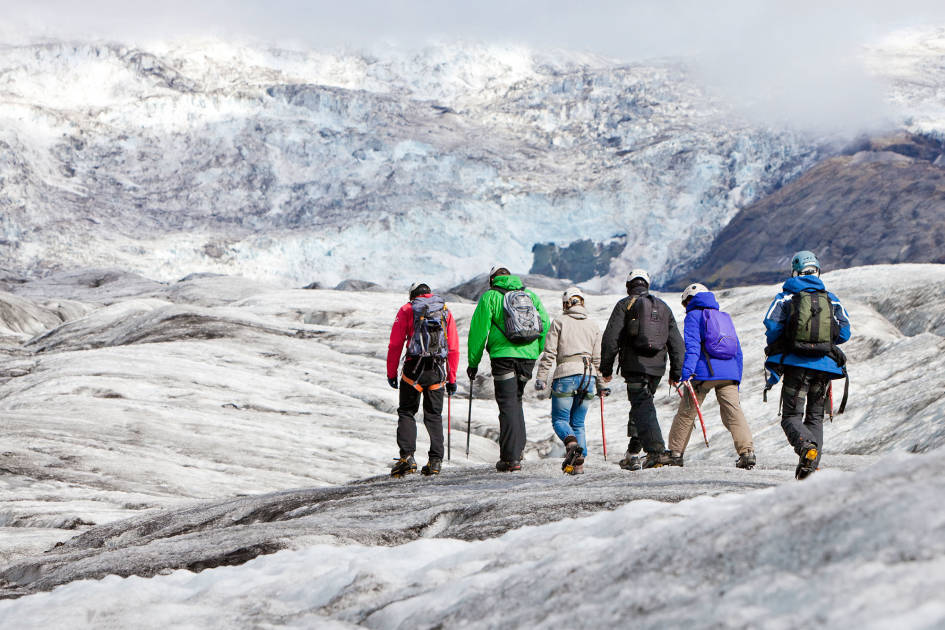
6. The Galapagos Islands, Ecuador
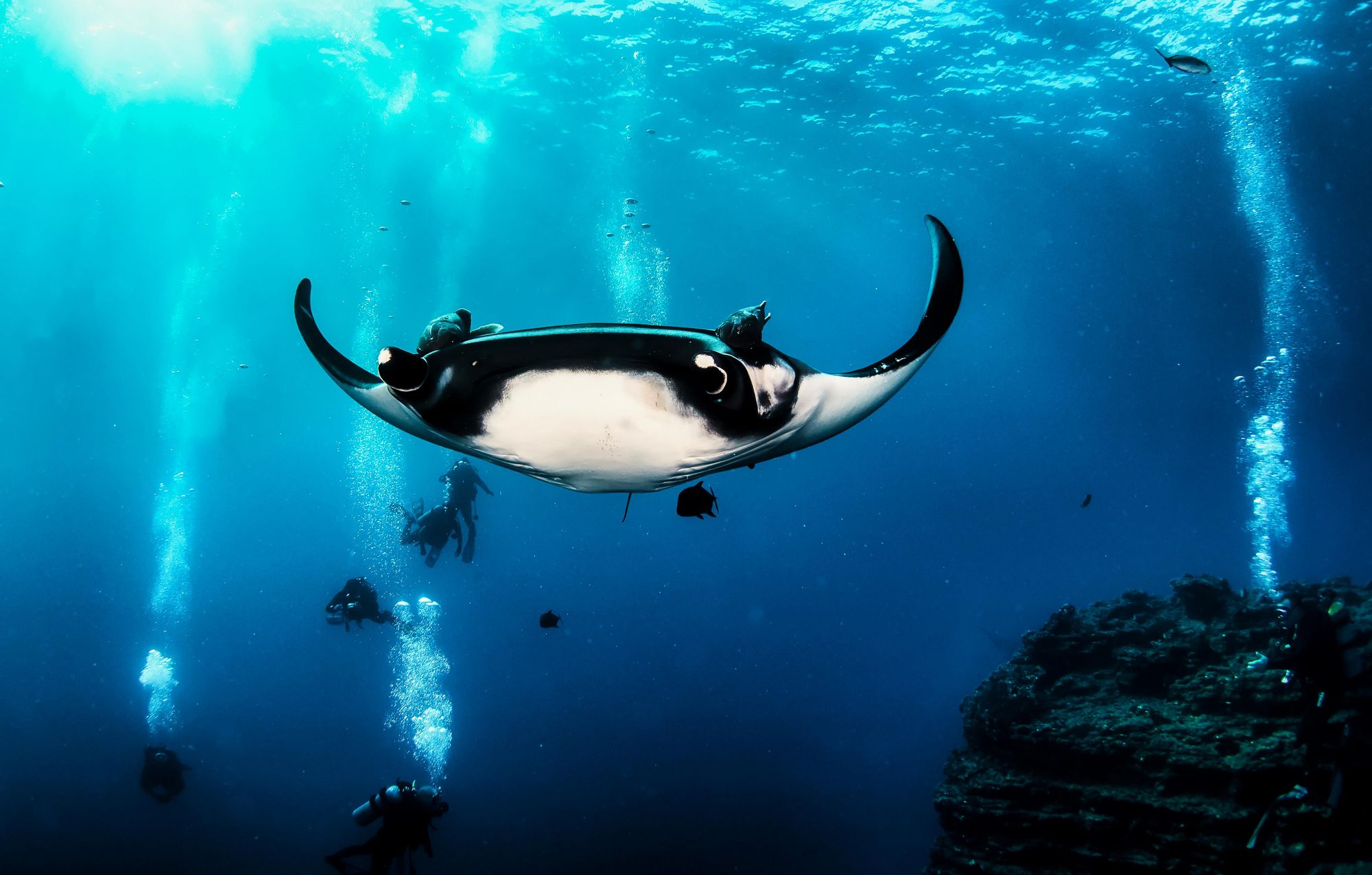
- Season: Warm and wet season
- Temperature: 31°C high, 22ºC low
- Time zone: GMT-5
- Currency: US Dollar
- Best for: Marine wildlife
The Galapagos is famed for the huge range of wildlife you can find there. Visit in February and you’ll be visiting at a time when the water is at its warmest and the wind is at its weakest, meaning that the conditions for snorkelling are absolutely ideal. Nip under the water and you could see rays, reef sharks, parrotfish, angelfish and more. In February, hundreds of green sea turtles come ashore to lay their eggs, so they are super easy to spot. You’ll find mockingbirds and finches out dining on the greenery that comes with the gentle rain too.
How to get there? The Galapagos Islands are reached from Ecuador, with most people flying in from the capital of Ecuador, Quito, to Baltra Island in the Galapagos.
Island Hopping Adventure in the Galapagos | Much Better Adventures
Join local experts for a Galapagos Islands adventure. Hike, bike and snorkel the unique archipelago on an action-packed adventure immersed in the natural world.
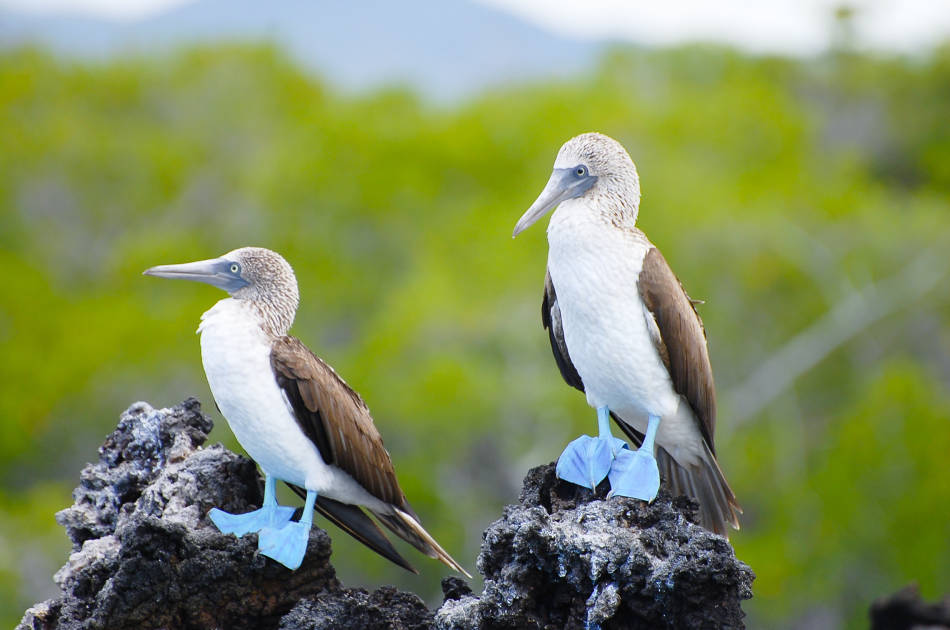
7. São Tomé and Príncipe, West Africa
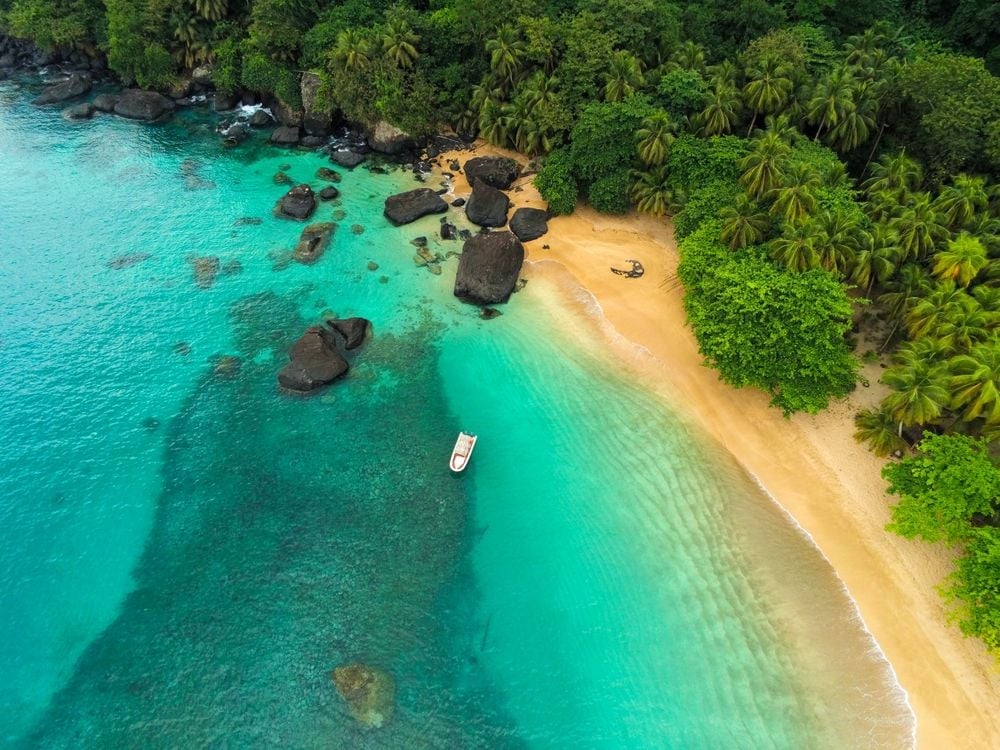
- Season: ‘Gravanito’ (the ‘small dry season’)
- Temperature: 30°C high, 25ºC low
- Time zone: GMT+0
- Currency: São Tomé and Príncipe dobra
- Best for: A truly off-the-beaten track adventure
From the Galapagos to a country often called the ‘African Galapagos’ – the dual equatorial islands of São Tomé and Príncipe (off the west coast of Africa).
This is one of the least visited countries in the world, so don’t expect to see a lot of tourists when you’re here. You can hike extinct volcanoes, walk to remote waterfalls and trek through a biosphere reserve, retiring to chill out on golden sand beaches and swim in the sea. Get lucky and you might find some turtles have come to join you. Expect to see the bruma seca on the coast; a haze which comes from the Saharan sands being blown west from the continent.
Do note, the heavens can open here in February, but rains pass – and after all, all that lush greenery needs a lot of water if it’s going to stay so fruitful.
How to get there? Reach the islands by flying to São Tomé International Airport (TMS).
Journey to the Equator in São Tomé and Principe | Much Better Adventures
Join a small group of adventurers in West Africa’s undiscovered archipelago, hiking to secluded beaches through primordial, forested landscapes.
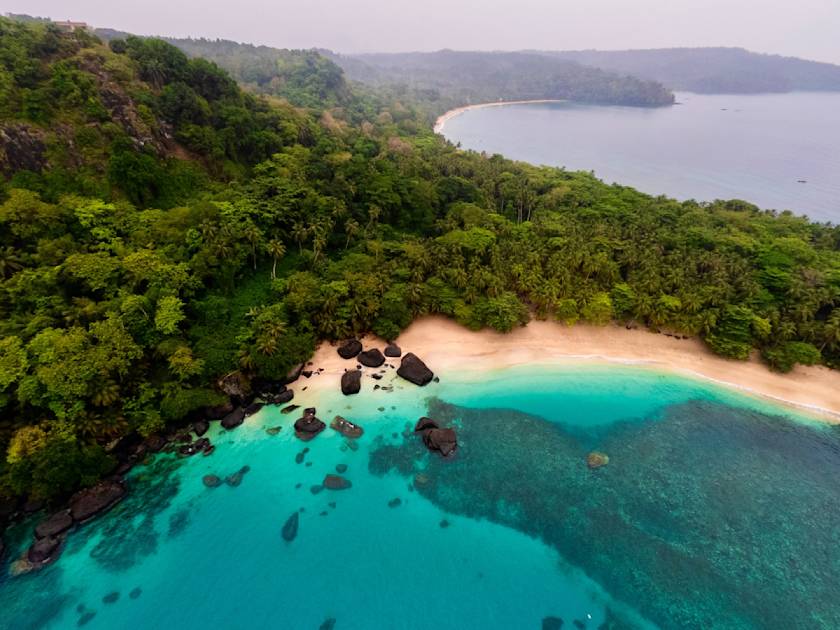
8. Havana and Beyond, Cuba
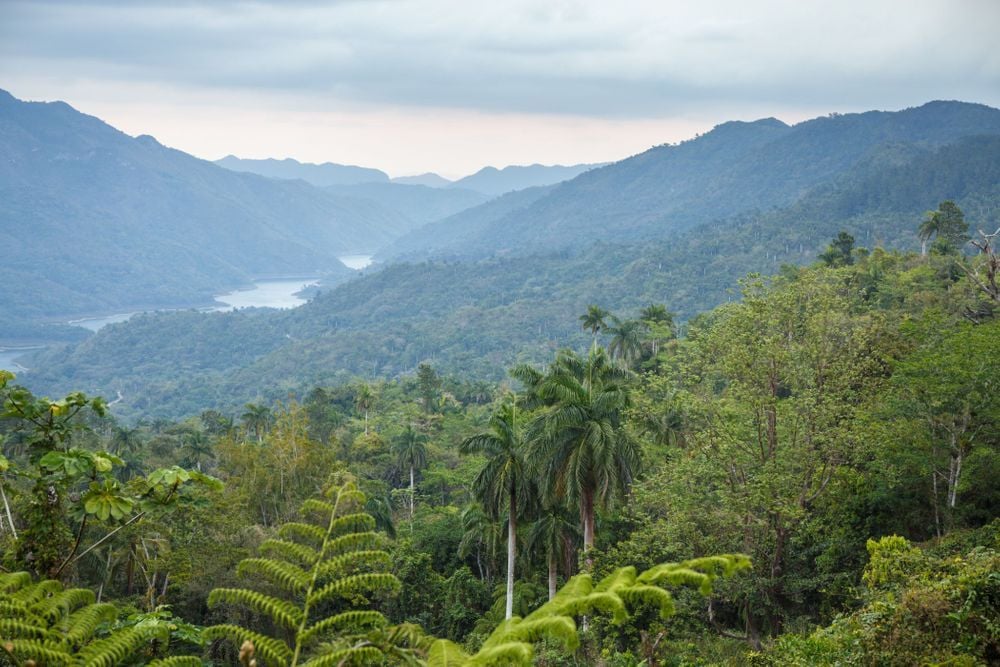
- Season: Dry season
- Temperature: 27°C high, 18ºC low (for Havana)
- Time zone: GMT-4
- Currency: Cuban Peso
- Best for: Mixing nature and cultural immersion
Cuba is a nation known for the colourful houses of Havana, the retro cars, and for the dominoes played on the streets. Visit and stay in casa particulares – authentic Cuban homestays – and you’ll discover the local side of life. “A casa particular is a private house which has been licensed to operate as a guesthouse – like a B&B but cooler,” says Adam Roberts, our resident Cuban expert at Much Better Adventures, having lived in the country for four and a half years. “I’ve learnt to play dominoes, drink rum and while away the hours with infectious chisme (gossip) in many casa patios – all rites of passage in Cuba.”
February is one of the hottest months of the year in Cuba, an ‘accidental Eden’ of wild beauty, from cascading waterfalls and idyllic beaches to mountain trails, fincas and tobacco plantations. Hike the lush Guanayara Trail of visit the emerald landscapes of Viñales and see it for yourself.
How to get there? Fly into the capital of Cuba, to Jose Marti Airport, Havana.
The Ultimate Adventure Through Cuba | Much Better Adventures
Join a small group of adventure travellers for an active journey through Cuba’s wild beauty, from waterfalls and beaches to mountain trails and fincas.
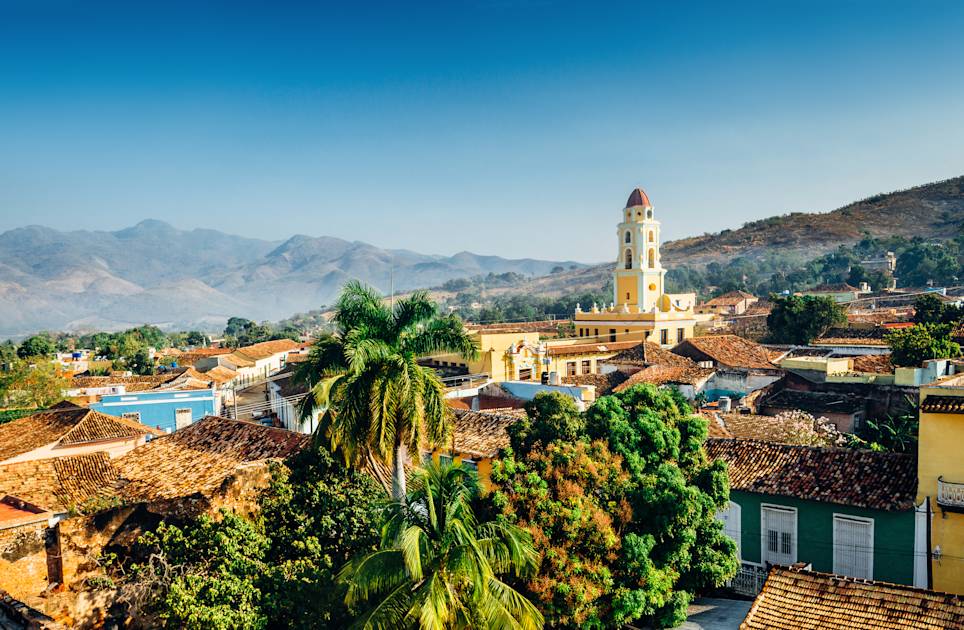
9. Kerala, India
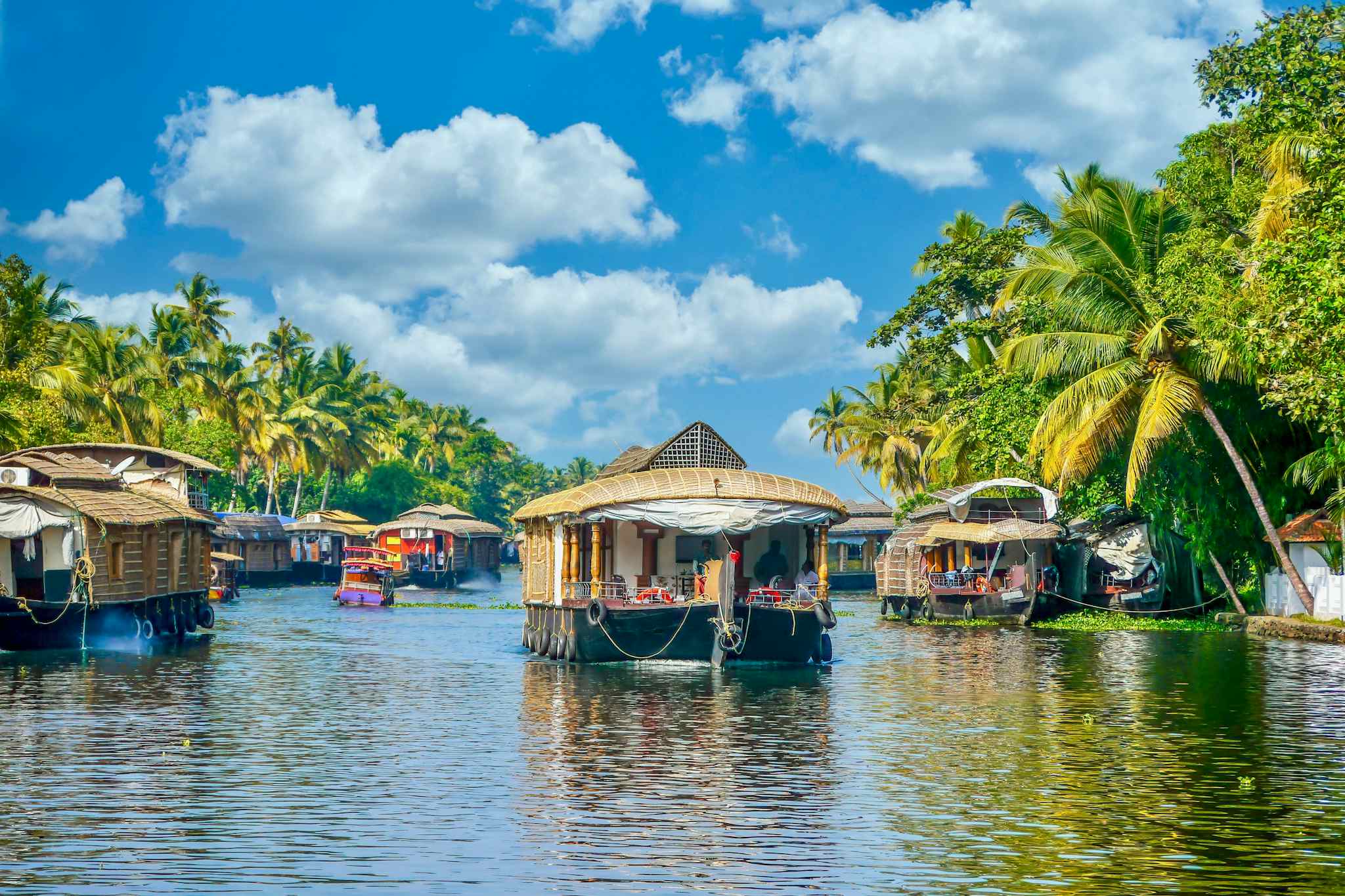
- Season: Dry season
- Temperature: 32°C high, 24ºC low
- Time zone: GMT+5:30
- Currency: Indian Rupee
- Best for: Wildlife and river cruising
Visit Kerala, India in February and you’ll be doing so when the temperatures are hot and the weather is dry – which for some makes it the ideal time to explore the backwaters by boat.
Cruise along the famous rivers of the region, lined by lush greenery, and you can take in the essence of Kerala. Visit a tea factory en route and relax in the kettuvalam – a traditional houseboat – that lets you discover the tranquillity of this colourful area.
The wildlife watching opportunities here are also heralded. Look out for elephants and tigers while you walk through the Periyar Tiger Reserve. Stretch out over a yoga session and relax on a beach, looking out over the glimmering Arabian Sea. And the food? It’s as good as you think.
How to get there? For Kerala, fly into Cochin International Airport (COK) in Cochin.
The Ultimate Adventure In Kerala | Much Better Adventures
Join a small group tour on this magical adventure through the mountains, tea plantations, tiger reserves, backwaters and dreamy coastline of India’s stunning southern state.
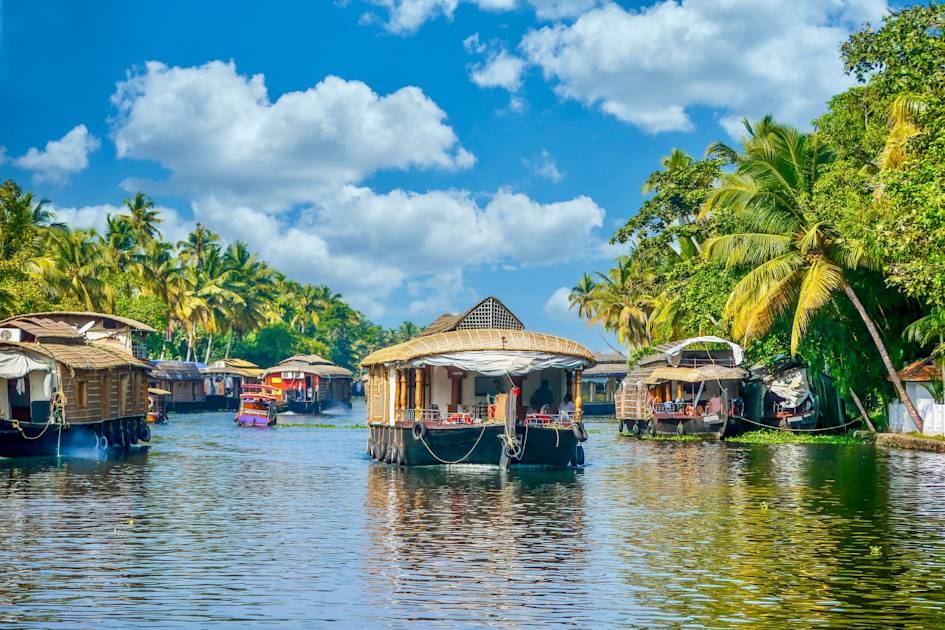
10. The Atlas Mountains, Morocco
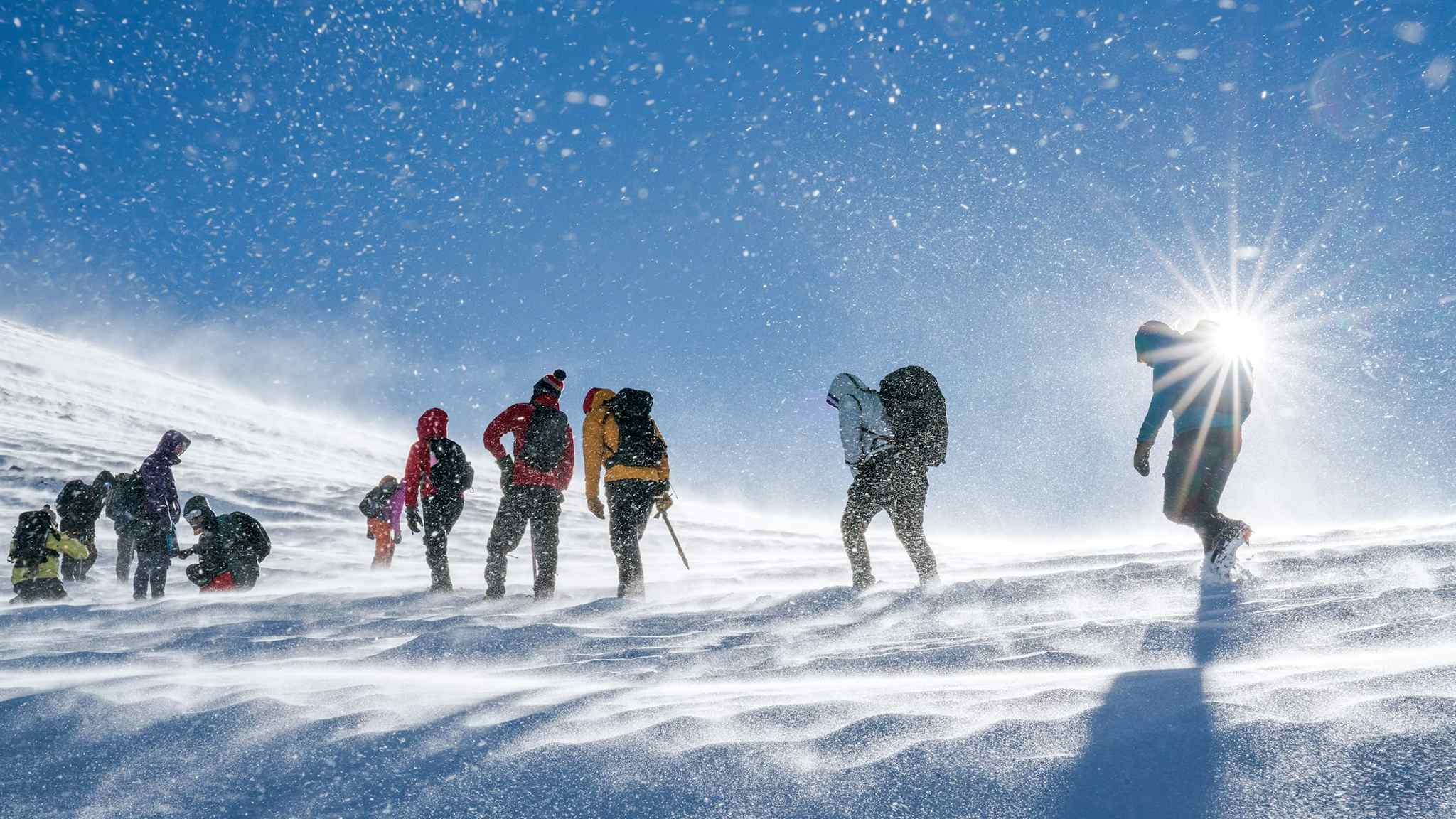
- Season: Winter
- Temperature: 16°C high, 3ºC low (for Imlil)
- Time zone: GMT+1
- Currency: Moroccan Dirham
- Best for: A winter weekend adventure
The Atlas Mountains are a hiker’s dream. We’re slightly in love with Mount Toubkal, which at 4,167m (13,665ft) is the highest peak in Morocco and North Africa. The ascent of Toubkal is a two-day climb, with an overnight at a high refuge en route. Do it in February and there’s a good chance that you’ll find yourself hiking through snow near the summit, with crampons and an ice axe required. If you’re looking for a challenge, and something very different, this could be it.
How to get there? Most people visiting the Atlas Mountains first fly into Marrakech Airport.
Climb Mount Toubkal: The Winter Edition | Much Better Adventures
Don your crampons for a serious adventure and trek your way up the mighty Mount Toubkal in the height of winter. Expert mountain guides will lead the way.
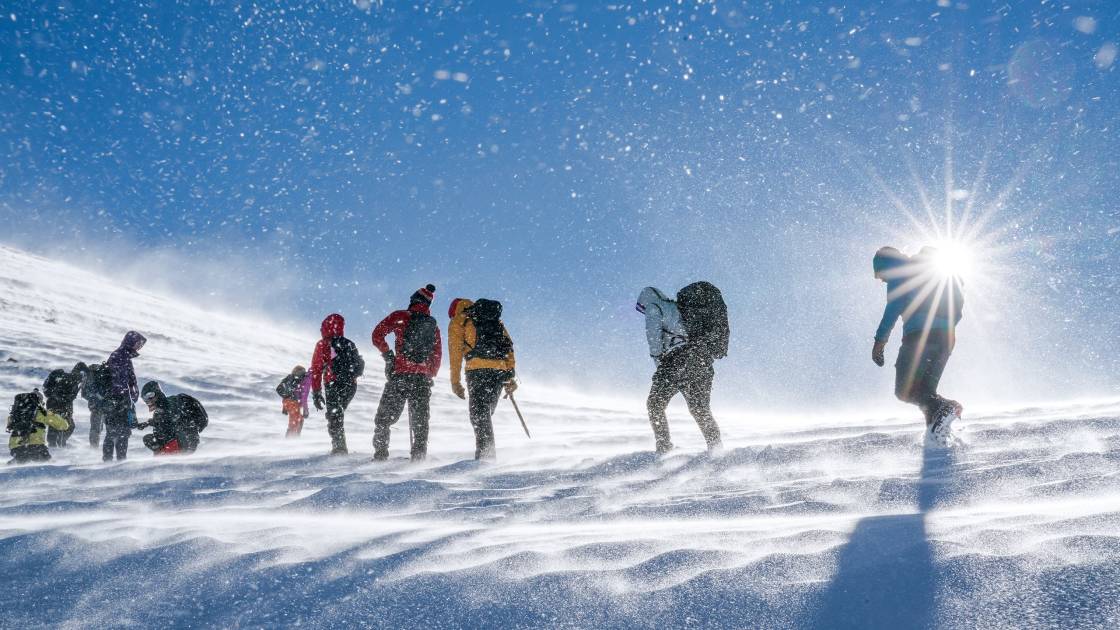
11. The Andes of Argentina
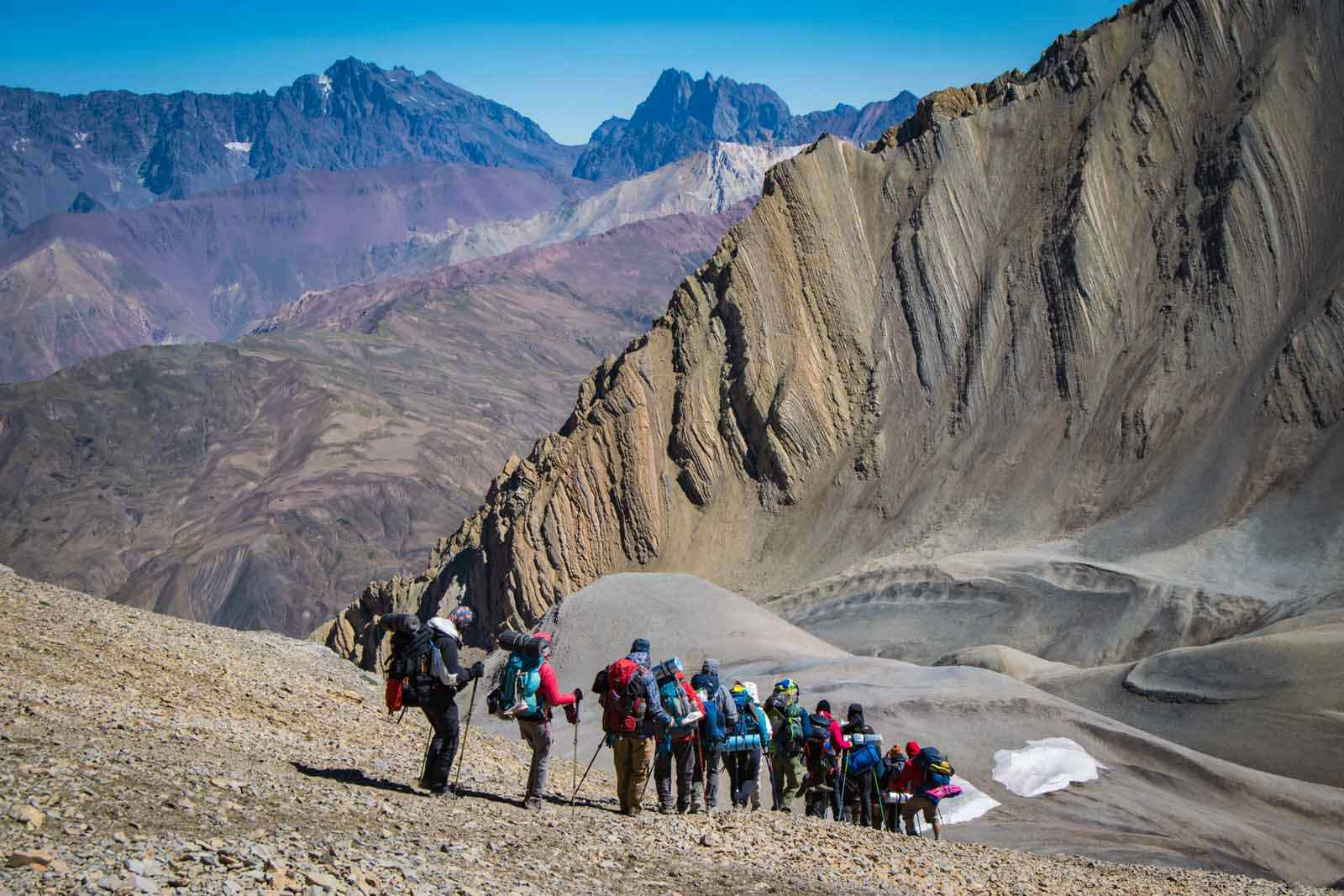
- Season: Summer
- Temperature: 31°C high, 17ºC low (for Mendoza)
- Time zone: GMT-3
- Currency: Argentine Peso
- Best for: Exploring the mighty Andes Mountains
February might be chilly in Europe and much of the US but it’s summertime in South America.
Visit the Andes of Argentina in February and trek into a proper wilderness – through deep valleys, remote gorges and across ancient glaciers. Keep your eyes open for condors, the giants of the sky, circling and looking for their next meal, and guanacos, the ancestor of the llama. Burst through the cloud line and tackle the Portillo Argentino high pass, topping out at an altitude of 4380m (14,370ft). The natural hot springs at Termas del Plomo come at just the right time, when the hard work of the hike is done. Oh, and this hike will drop you off in Chile’s wine region. So there’s certainly something to look forward to at the end.
How to get there? This trek runs from Argentina from Chile. Access at the beginning is from Mendoza Airport, Argentina. After the hike, the most accessible is Santiago de Chile Airport.
Trek from Argentina to Chile Across the Andes | Much Better Adventures
Join a small group of adventurers to traverse the spine of South America, hiking over the remote Piuquenes Pass and wild camping under the stars.
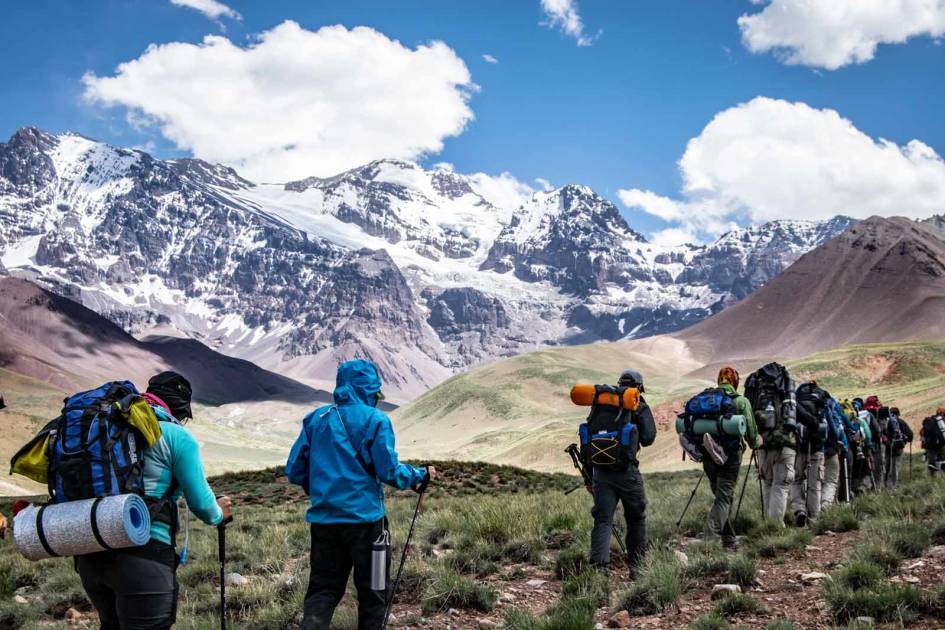
12. South Ari Atoll, The Maldives
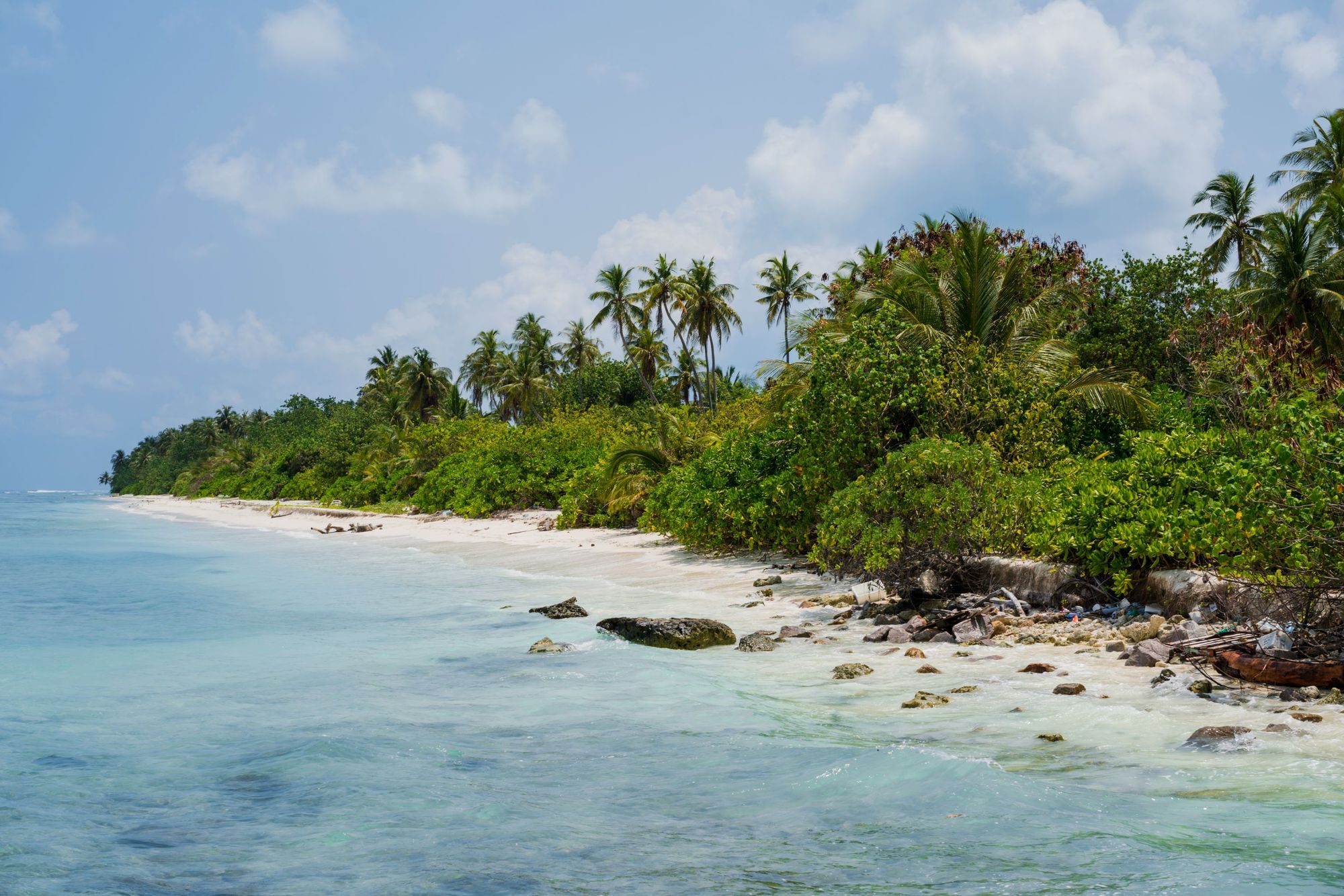
- Season: Dry
- Temperature: 30°C high, 25ºC low
- Time zone: GMT+5
- Currency: Maldivian Rufiyaa
- Best for: A true winter sun adventure
Most people know the Maldives as a travel destination for luxury, all-inclusive tourism. You fly, you flop, you fry, and the local community doesn’t get a whole lot out of the experience. But there is so much more to the Maldives than that. Use local guides and hosts and you can experience the authentic side of the Maldives – swimming with whale sharks, snorkelling amongst kaleidoscopic reefs, and kayaking and SUPing around tropical islands – all while participating in a regenerative form of tourism that gives back to both local people and planet.
Warning: visit the Maldives in February and your friends back home will be seriously jealous.
How to get there? Fly to Male International Airport. From here, you can reach the atoll with a one hour speedboat ride to Fulidhoo.
Island Hopping Adventure in the Real Maldives | Much Better Adventures
Relax into authentic island life on this easygoing adventure in South Ari Atoll, paddling in tropical waters away from the resorts with a local guide.

13. Palawan and Coron, The Philippines
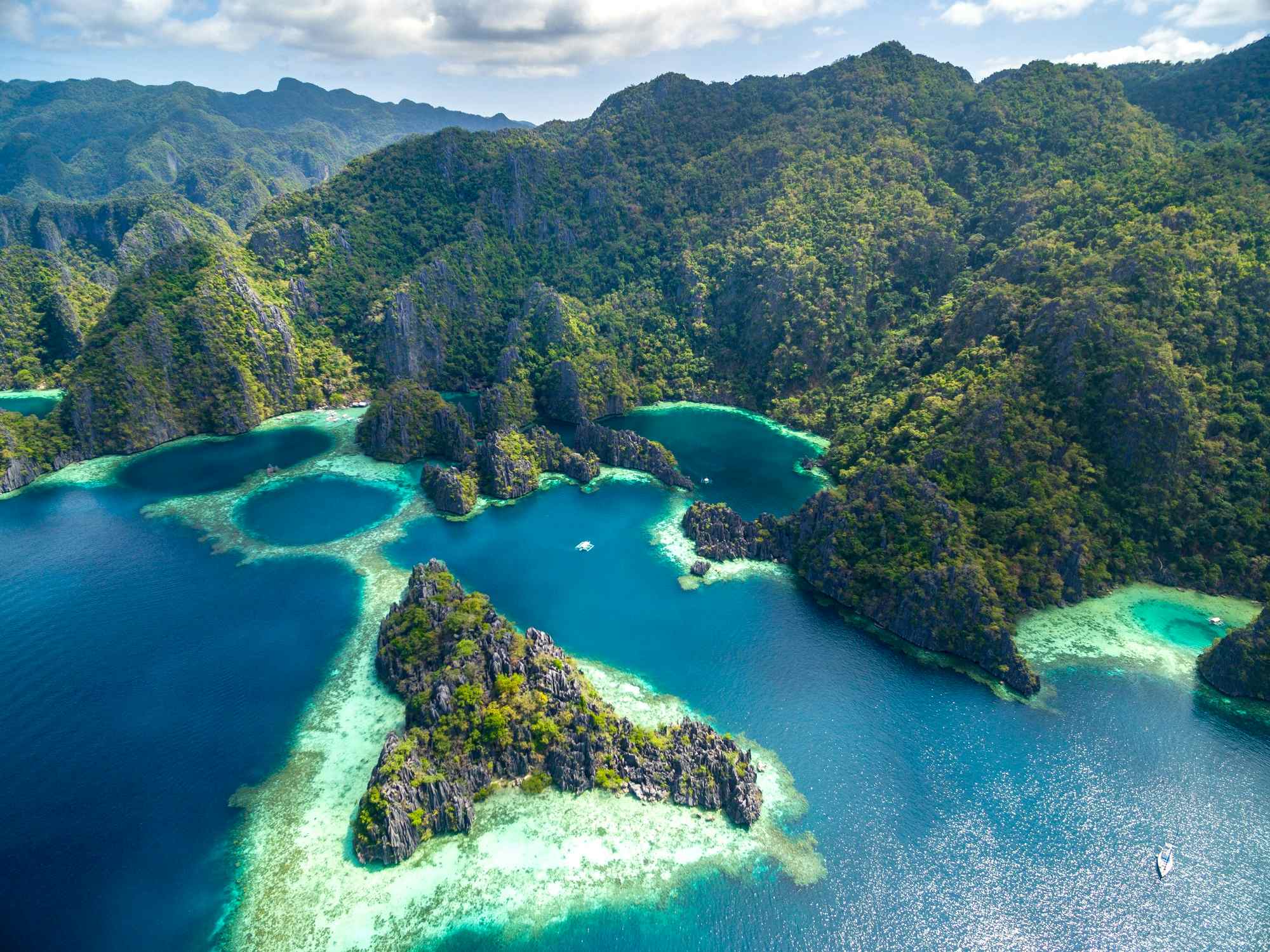
- Season: Dry season
- Temperature: 31°C high, 23ºC low
- Time zone: GMT+8
- Currency: Philippine peso
- Best for: A truly tropical February
Go for an island-hopping adventure on the tropical islands of Palawan and Coron and transform your February into a life-changing experience. Imagine steep cliffs, islands and huge mountains, all completely coated in lush greenery and looking down on turquoise water (or indeed, just look at the picture above).
Go snorkelling amongst colourful coral reefs, hike dense jungle trails, paddle through limestone karst pillars in the Sulu Sea and unwind and relax in the natural thermal waters of Maquinit. February is part of the cool dry season, at the start of the year. During this period you can both avoid the rain in the Philippines, and avoid the highest heats, which come from March to May.
How to get there? Fly to into Aquino International Airport, Manila and then it’s an internal, 1.5-hour flight to Puerto Princesa to arrive in Palawan.
The Ultimate Island Hopping Adventure in The Philippines | Much Better Adventures
Join an epic group adventure on the tropical islands of Palawan and Coron, exploring coral reefs and turquoise coves in the Southeast Asian archipelago.
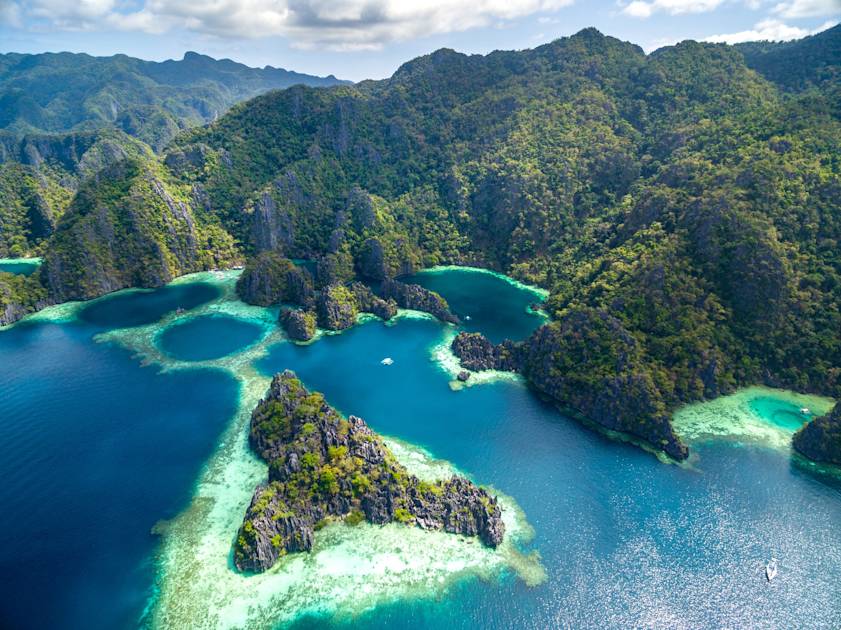
14. The Yucatan Peninsula, Mexico
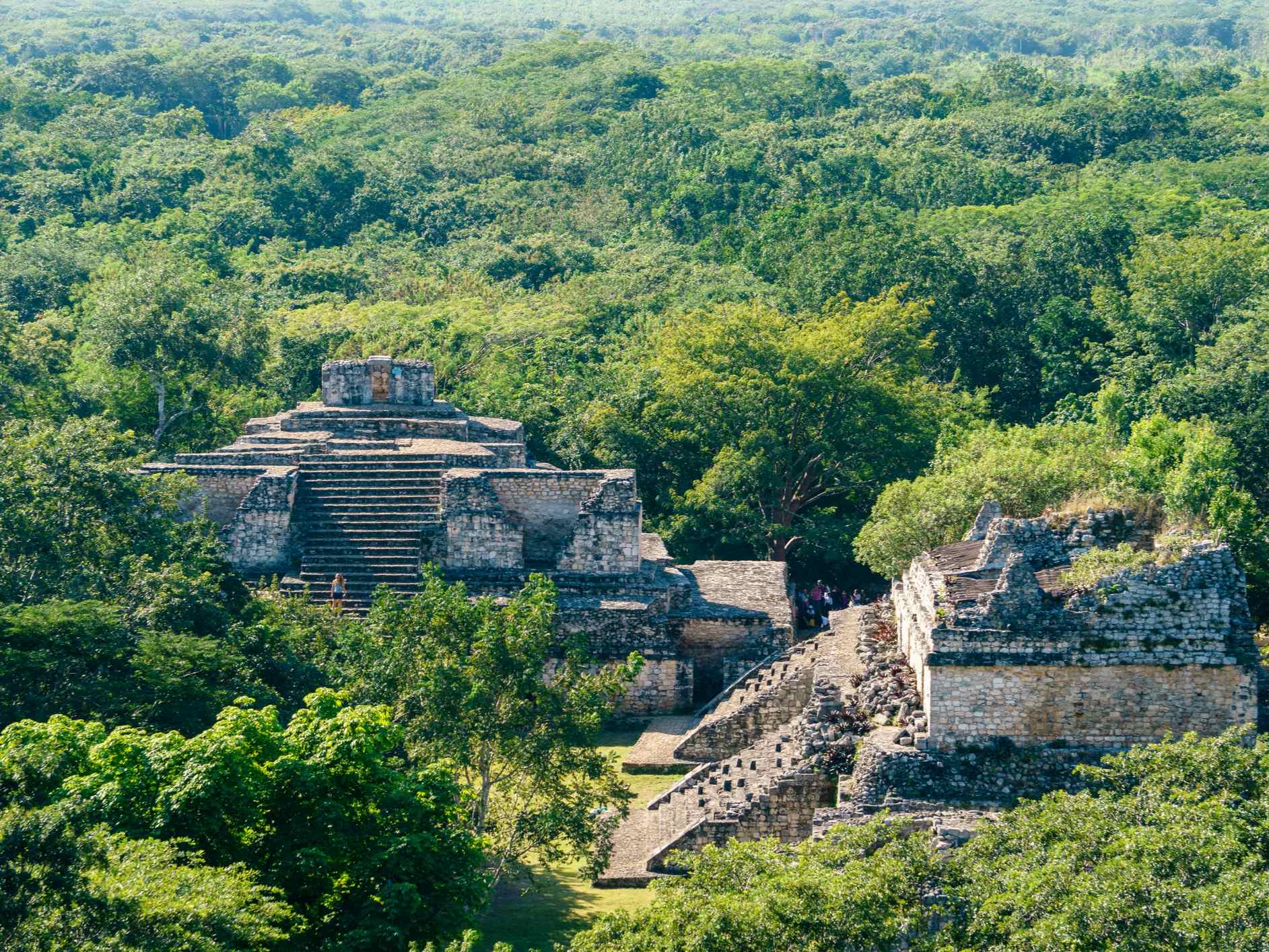
- Season: End of the dry season
- Temperature: 30°C high, 19ºC low
- Time zone: GMT-6
- Currency: Mexican Peso
- Best for: Mixing ancient archaeology and wild nature
The iconic Yucatan Peninsula brings up different thoughts for a lot of people. For us, it’s wild jungle trails, tropical, untouched beaches, deep, mystical cenotes – and remarkable Mayan sites, surrounded by greenery, and truly unlikely anything you’ll see anywhere else in the world.
Explore the secret ruins of Ek Balam, Coba and Muyil, immersing yourself in Mayan history without the busy crowds. Float in the crystalline waterways of Sian Ka’an, dip into a mud bath in Rio Lagartos and chill in the beach paradise of El Cuyo. And hike, cycle and paddle your way through this sensational landscape. In February, the rain is minimal and the conditions ideal.
How to get there? For the Yucatan Peninsula, you’ll want to fly into Cancun Airport.
The Ultimate Adventure in Mexico’s Yucatan Peninsula | Much Better Adventures
Join a small group of travellers on an active adventure in the Yucatan, exploring mystical Mayan sites, sparkling cenotes and dazzling beaches as you go.
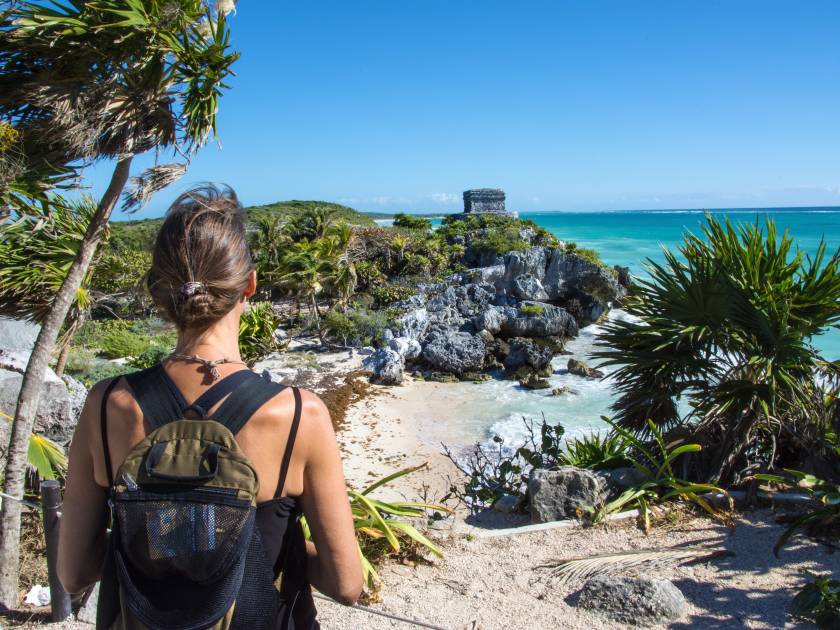
15. Koh Trong, Cambodia
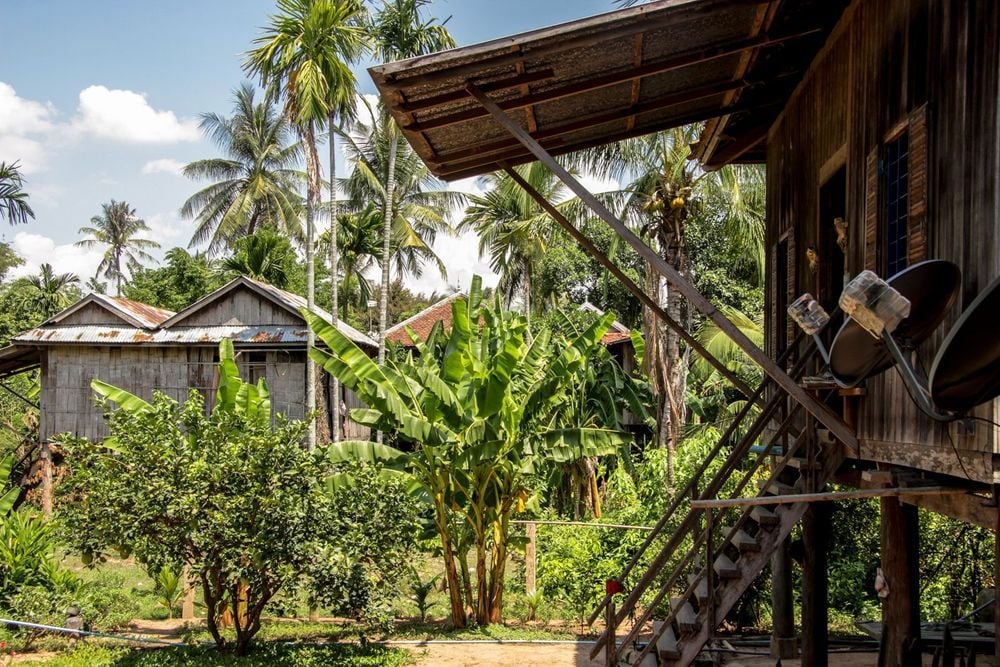
- Season: Dry season
- Temperature: 28°C high, 20ºC low
- Time zone: GMT+7
- Currency: Cambodian riel
- Best for: River views and jungle outings
You’ll find good weather throughout Cambodia in February, with the hottest months of the year just ahead, and the coolest and rainiest times behind. Use that as a good excuse to head to the wild places of the country, exploring the ancient temples and waterways. The Ratanakiri jungle and Phnom Kulen National Park make for great hiking. Kayak along the legendary Mekong River, keeping an eye open for the rare Irrawaddy dolphins, and cycling around Koh Trong Island, where tourism is providing a valuable new income stream for locals.
Kayak along the legendary Mekong River, keeping an eye open for the rare Irrawaddy dolphins.
You can’t leave Cambodia without visiting Angkor Wat and the Angkor Thom temples. The city of Angkor was home to around 900,000 people in its prime, in the 13th century.
How to get there? Reach Cambodia by flying into the Phnom Penh International Airport.
Roam the Jungles and Temples of Cambodia | Much Better Adventures
Join a small group to get off the beaten track in Cambodia. Explore the Angkor temples and the Mekong River by kayak, bike and on foot with local guides.
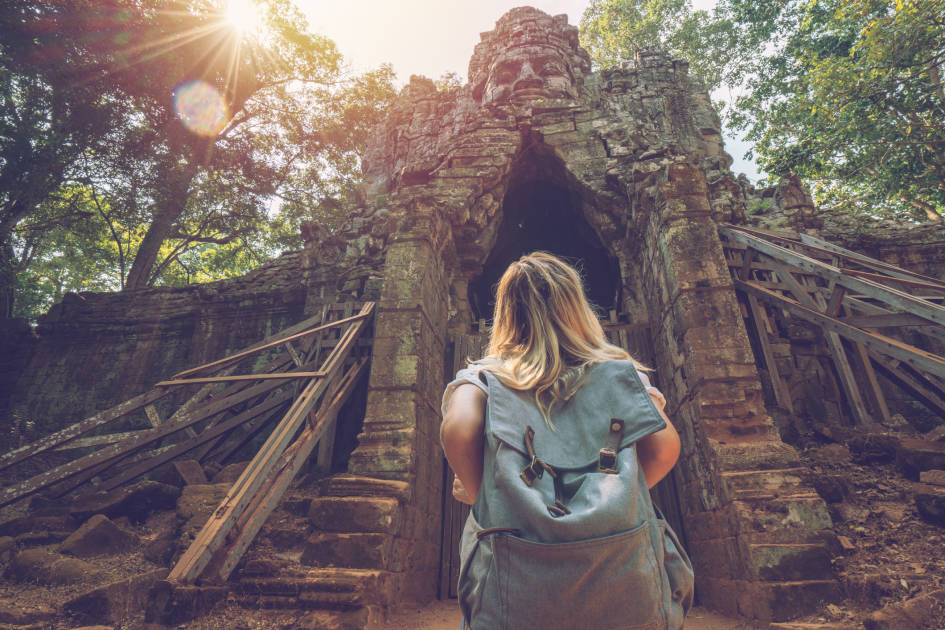
16. Tian Shan Mountains, Kyrgyzstan
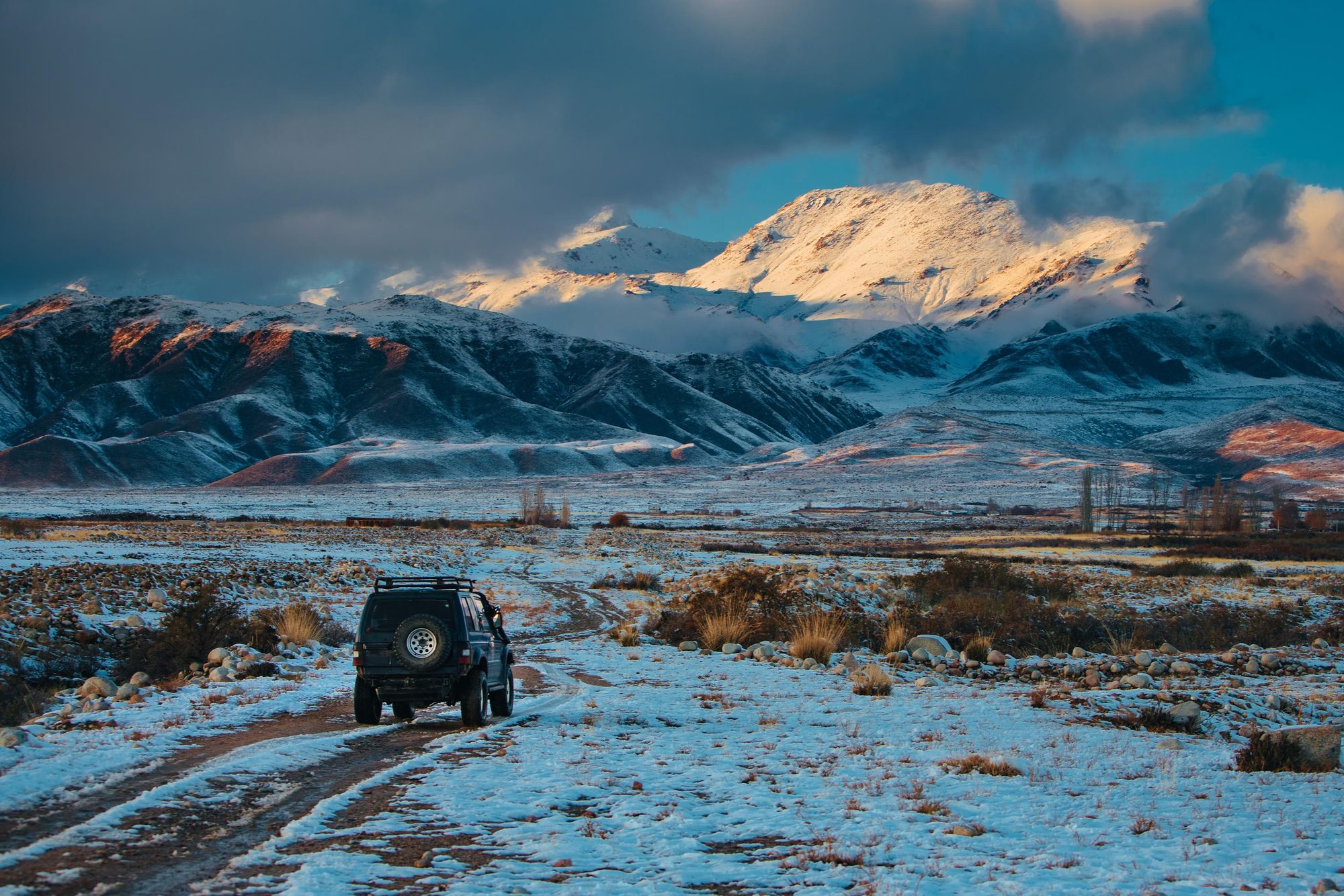
- Season: Winter
- Temperature: 5°C high, -7ºC low
- Time zone: GMT+6
- Currency: Kyrgystani Som
- Best for: The truly intrepid traveller
Think Kyrgyzstan and there’s a good chance that you think of big mountains and vast wilderness. If you do, then you’re thinking of the Tian Shan Mountains. This is one of the most spectacular mountain ranges in Central Asia. Visit during February and you can expect to find snow – but with that comes a magical landscape, and the opportunity for a truly intrepid experience, far off the beaten track. Take to the Kyrgyz steppe on horseback and explore the mountains of the Tian Shan range. Meet the eagle hunters and yurt crafters, and get warm in traditional bana saunas and thermal hot springs at the end of the day. This is a special one.
How to get there? The most popular way to reach Kyrgyzstan is to fly into Manas International Airport in Bishkek.
Kyrgyzstan in Winter: Snowshoeing, Horseriding & Sauna Trip | Much Better Adventures
Join a small group tour on this winter adventure of hiking, horse riding and snowshoeing through Kyrgyzstan, warming up in banya saunas as you go.
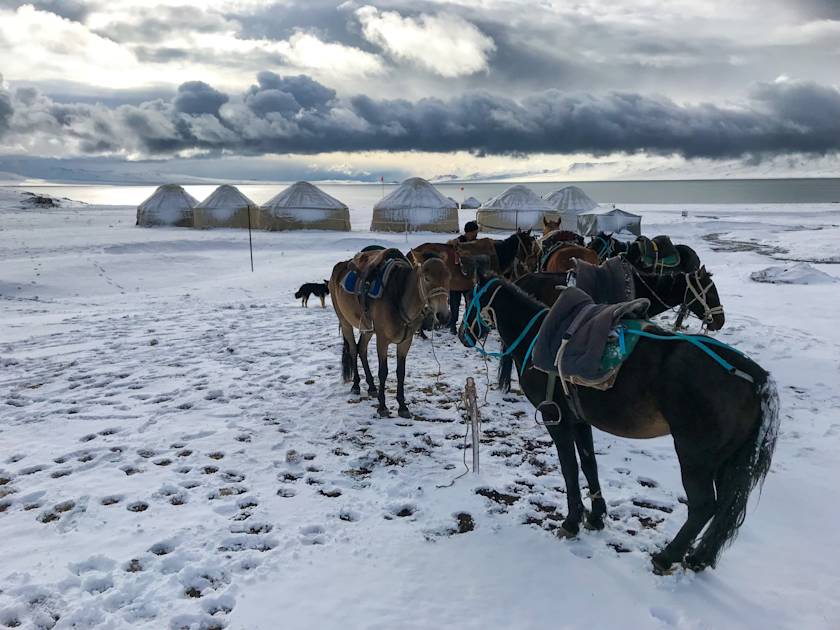
17. Ben Nevis, Scotland
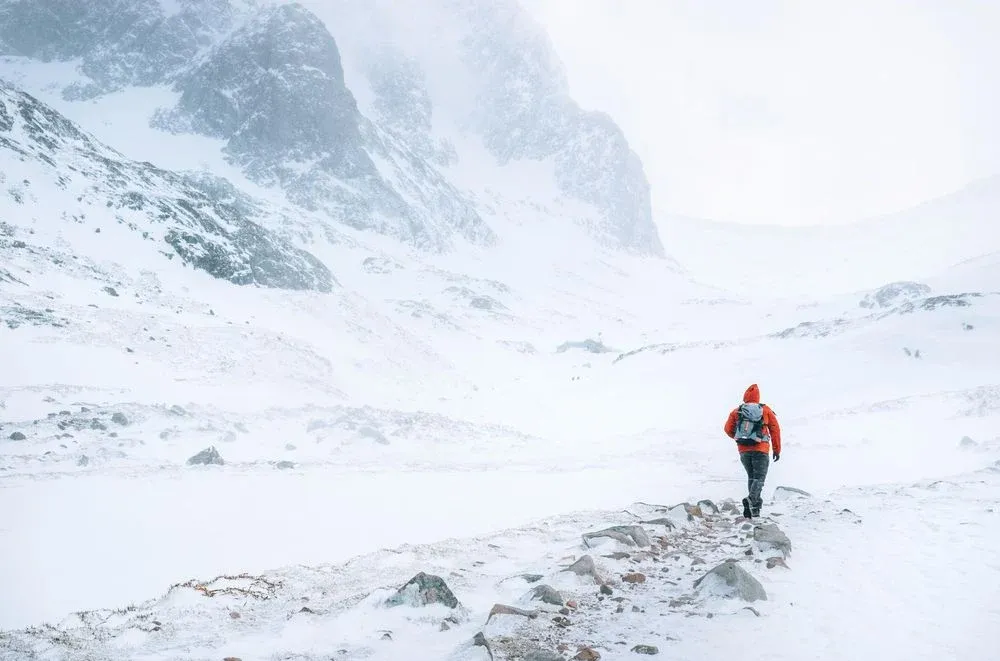
- Season: Winter
- Temperature: 7°C high, -1ºC low (for Fort William)
- Time zone: GMT+1
- Currency: Great British Pound
- Best for: Learning winter mountain skills
The Scottish Highlands are beautiful year-round, but go in February and you have a good chance of finding snow on the peaks. Fort William is often described as the outdoor capital of Scotland, sitting at the base of Ben Nevis, the highest peak in the UK. Beyond this, it also has sensational access to scenic glens and lochs (and there’s some dynamite pubs too). Of course, Fort Bill gets real busy in the summer, but visit in February and you’ll find it a lot less crowded; with most people either locals, or adventurers who have come for winter climbing. This is a great time to travel up, hire a good guide and learn the essentials of winter mountaineering.
How to get there? You can reach Fort William on the train from Glasgow or London.
Climb Ben Nevis in Winter | Much Better Adventures
Join a small group with a local guide to learn essential winter mountain skills and summit Ben Nevis. Book your next Much Better Adventure today.

18. The Himalayas, Nepal
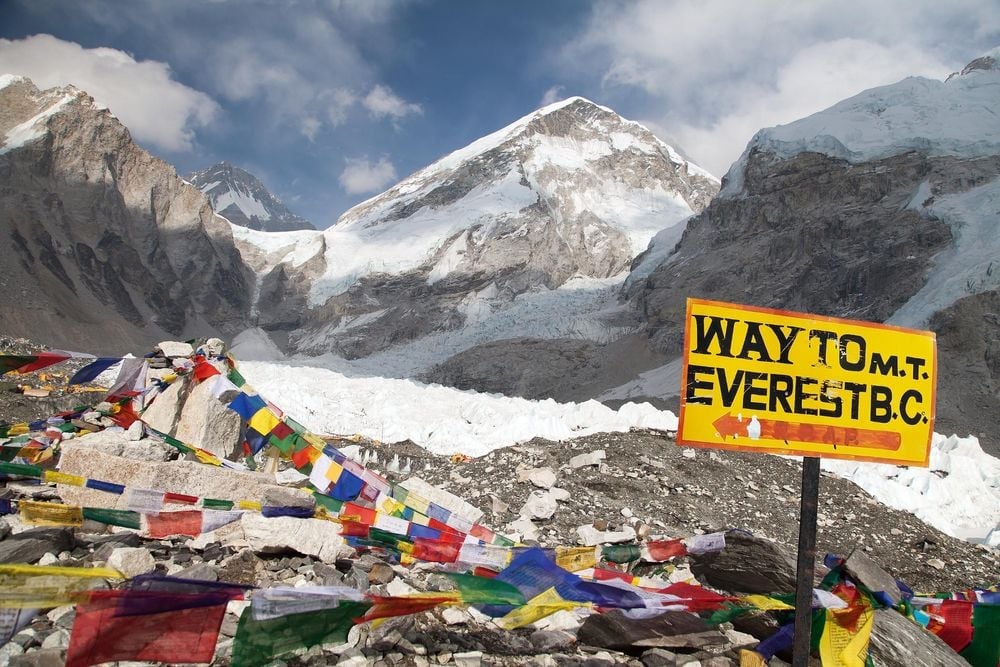
- Season: Winter
- Temperature: 6°C high, -7ºC low (for Lukla)
- Time zone: GMT+5:45
- Currency: Nepalese Rupee
- Best for: A full Himalayan experience
If you’re interested in hiking then Nepal is not a country which requires a blurb.
This is the home of the mighty Himalayas – where mountaineers from the world over gather to ascend the highest mountains in the world. Come in February and you’ll be coming just as winter is slipping into spring. Yup, it’ll be cold – but that comes with crisp air, and often, clear skies. Walk to Everest Base Camp on Lukla, take on the Annapurna Circuit or if you’ve caught the mountaineering bug, test yourself at high altitude by climbing Mera Peak.
How to get there? You’ll first need to get to Kathmandu. If it’s the Everest Base Camp trek that you’re doing, you’ll then want to fly on to the famous Tenzing-Hillary airport in Lukla.
Climb Mera Peak (6461m) | Much Better Adventures
Join expert climbing guides in the Himalayas to conquer the highest trekking peak in Nepal and bask in epic views of the world’s highest mountains.
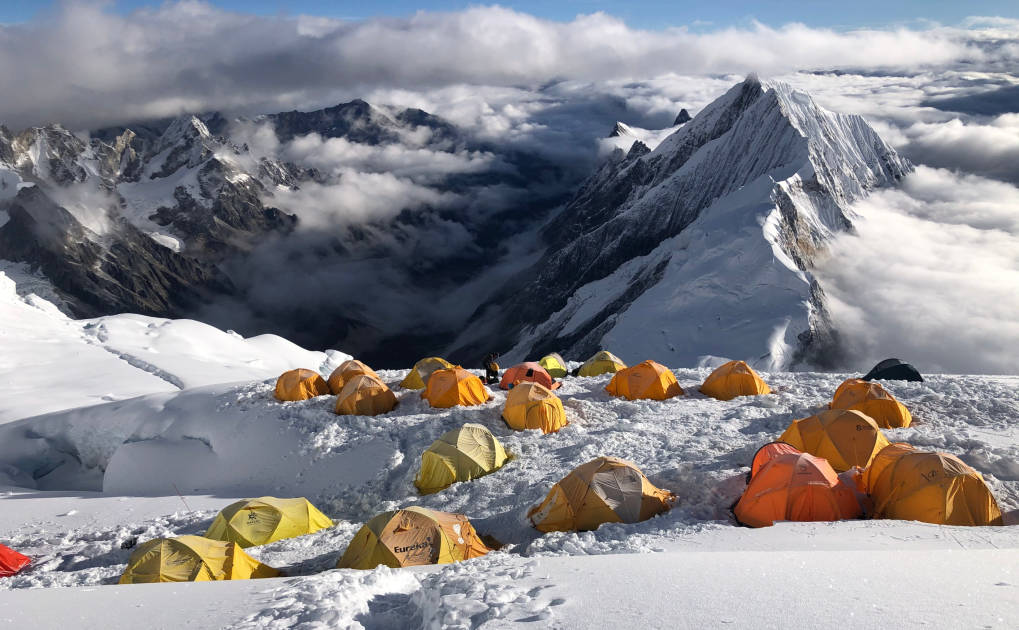
19. Cao Bang, Vietnam
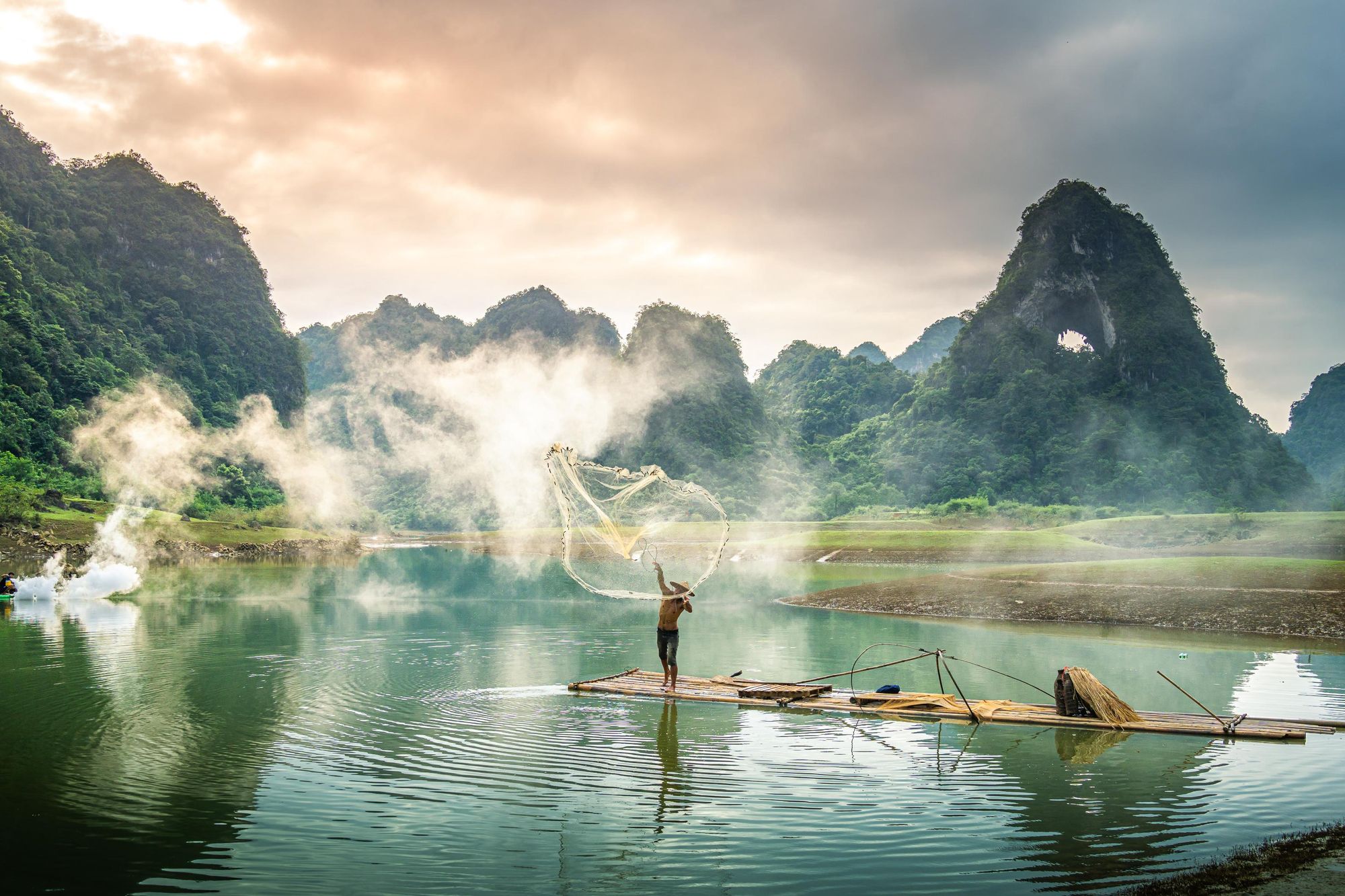
- Season: Dry season
- Temperature: 20°C high, 10ºC low
- Time zone: GMT+7
- Currency: Vietnam Dong
- Best for: Jungle escapism
Head to northern Vietnam and you’ll find a beautiful region, perhaps best known for the Bản Giốc Waterfall, the fourth largest in the world. It looks an awful lot like the sort of thing fictional movie characters stumble across on their way to the Lost City of Atlantis, with water gushing over lush greenery and idyllic lagoons layering below. February is the dry season here, meaning that won’t have to worry about rain so much when you’re taking in all those splendid views.
Visit the falls, trek through the mountainous province of Cao Bang, staying in homestays along the way and eating mouthwatering Vietnamese food as you go.
How to get there? Fly to Hanoi and then you can grab a five hour bus to Cao Bang.
Trek the Remote Trails of Northern Vietnam | Much Better Adventures
Join a small group of adventurers to explore a wild corner of Southeast Asia, on this remote trek in Vietnam’s far north. Led by local, expert guides.

20. Ankasa, Ghana
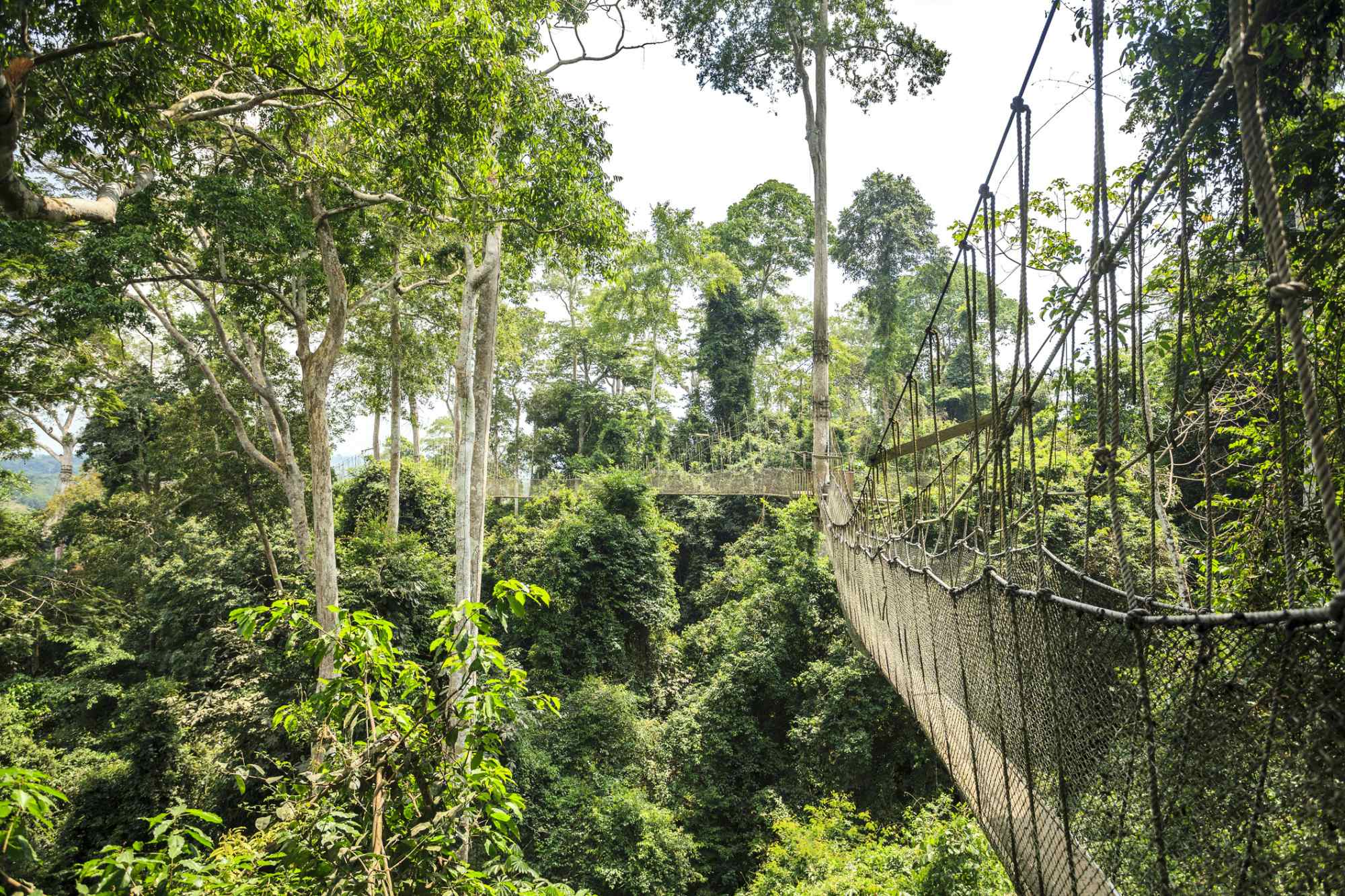
- Season: Dry season
- Temperature: 33°C high, 26ºC low (for Accra)
- Time zone: GMT+0
- Currency: Ghanaian Cedi
- Best for: A west African adventure
February is a dry month in Ghana, so it’s the perfect time to explore the wild spots of the country. Take to the south and you can launch an overlanding adventure from the Volta River to the pristine forests of Ankasa, the most biodiverse rainforest in the country (home to forest elephants, leopards, three species of pangolin and several primate species). Climb to the highest point in all of Ghana, Afadjato (885m/7,375ft), swim beneath the tallest waterfalls in the country and take to the canopies of Kakum National Park, another great place to spot wildlife.
How to get there? Start your adventure by flying into the Accra Kotoka International Airport.
The Ultimate Adventure in Ghana | Much Better Adventures
Join an active, small group adventure in West Africa, road-tripping through Ghana’s wild landscapes, remote villages & unique Ashanti Kingdom festivities.
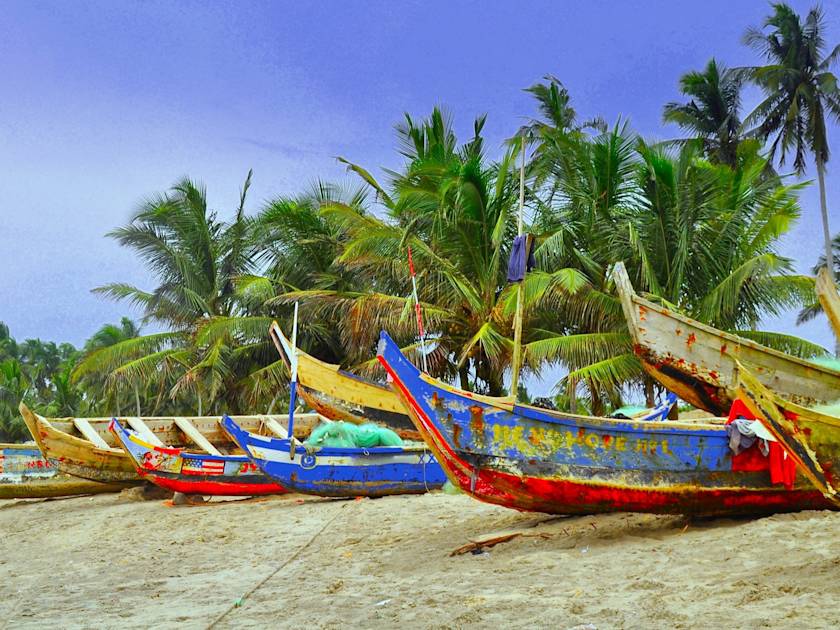
Inspired? Check out our full range of adventure holidays now!

